Forums
- Forums
- Axis And Allies Forum
- General Discussion
- Aviation News
Aviation News
Post a reply
- Go to Next topic
- Go to Welcome
- Go to Introduce Yourself
- Go to General Discussion
- Go to Screenshots, Images and Videos
- Go to Off topic
- Go to Works in Progress
- Go to Skinning Tips / Tutorials
- Go to Skin Requests
- Go to IJAAF Library
- Go to Luftwaffe Library
- Go to RAF Library
- Go to USAAF / USN Library
- Go to Misc Library
- Go to The Ops Room
- Go to Made in Germany
- Go to Campaigns and Missions
- Go to Works in Progress
- Go to Juri's Air-Raid Shelter
- Go to Campaigns and Missions
- Go to Works in Progress
- Go to Skinpacks
- Go to External Projects Discussion
- Go to Books & Resources
-
9 years agoFri Jul 10 2015, 02:51pm
 Main AdminPACIFIC OCEAN (July 8, 2015) ? Sailors launch an F/A-18F Super Hornet, assigned to the ?Bounty Hunters? of Strike Fighter Squadron (VFA) 2, from the flight deck of the aircraft carrier USS Ronald Reagan (CVN 76). Reagan is underway off the coast of southern California. (U.S. Navy photo by Mass Communication Specialist 3rd Class Nathan Burke/Released)
Main AdminPACIFIC OCEAN (July 8, 2015) ? Sailors launch an F/A-18F Super Hornet, assigned to the ?Bounty Hunters? of Strike Fighter Squadron (VFA) 2, from the flight deck of the aircraft carrier USS Ronald Reagan (CVN 76). Reagan is underway off the coast of southern California. (U.S. Navy photo by Mass Communication Specialist 3rd Class Nathan Burke/Released)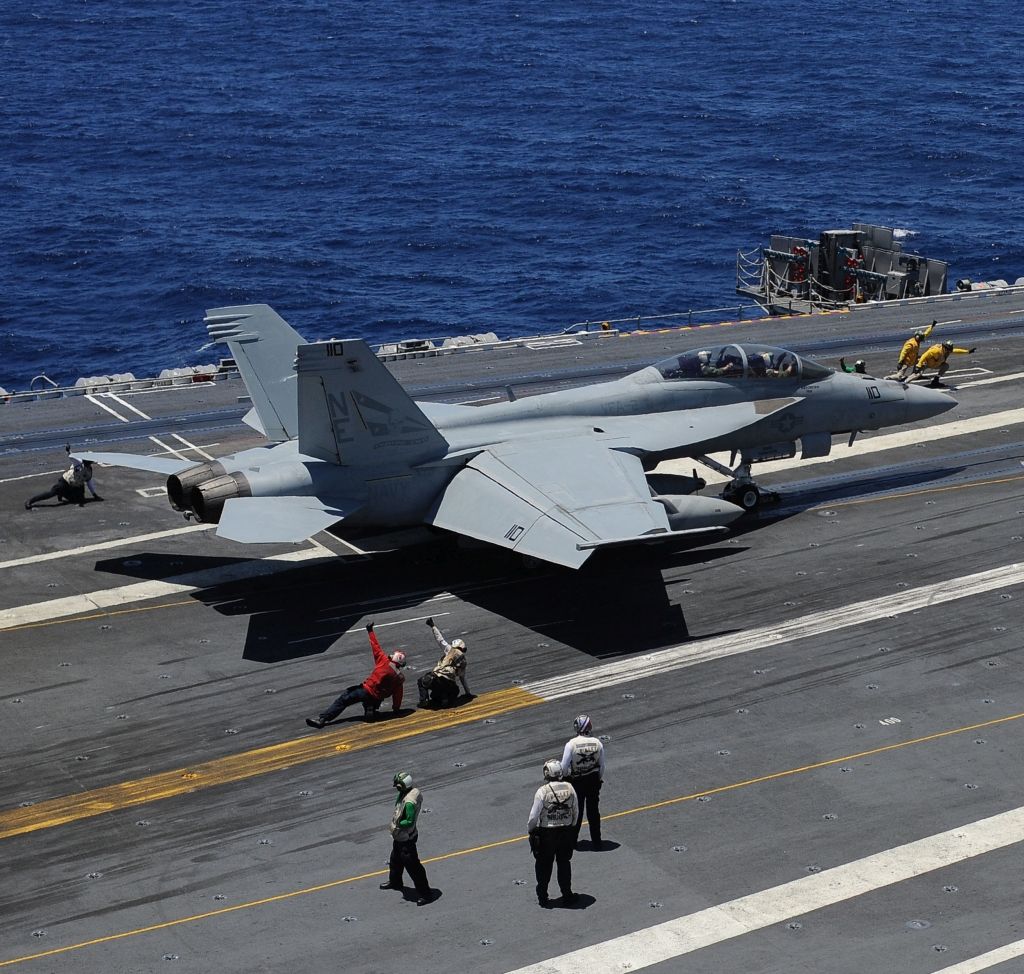
Jul 8, 2015
WASHINGTON, D.C. ? The United States Air Force (USAF) and National Nuclear Security Administration (NNSA) completed the first development flight test of the B61-12 nuclear gravity bomb at Tonopah Test Range in Nevada on July 1, 2015.
?This test marks a major milestone for the B61-12 Life Extension Program, demonstrating end-to-end system performance under representative delivery conditions,? said NNSA Deputy Administrator for Defense Programs Dr. Don Cook. ?Achieving the first complete B61-12 flight test provides clear evidence of the nation's continued commitment to maintain the B61 and provides assurance to our allies.?
The flight test asset consisted of hardware designed by Sandia National and Los Alamos National Laboratories, manufactured by the National Security Enterprise Plants, and mated to the USAF tail-kit assembly, designed by The Boeing Company. This test is the first of three development flight tests for the B61-12 Life Extension Program (LEP), with two additional development flight tests scheduled for later this calendar year. This test demonstrated successful performance in realistic flight environments followed by an effective release of a development test unit from a USAF F-15E from Nellis AFB. Telemetry, tracking and video data were successfully collected. This test provides confidence in the weapon system and instrumentation system designs and the hardware at its current state prior to going to a baseline design review in 2016.
The B61-12 LEP entered Development Engineering in February 2012 after approval from the Nuclear Weapons Council, a joint Department of Defense and Department of Energy/NNSA organization established to facilitate cooperation and coordination between the two departments as they fulfill their complementary agency responsibilities for U.S. nuclear weapons stockpile management. The B61-12 LEP is a joint USAF and NNSA program that preserves a critical element of the U.S. Nuclear Triad and demonstrates continued support for extended deterrence and assurance commitments.
The B61-12 LEP refurbishes both nuclear and non-nuclear components to extend the bomb?s service life while improving its safety, security and reliability. With the incorporation of an Air Force provided tail-kit assembly, the B61-12 will replace the existing B61-3, -4, -7, and -10 bombs.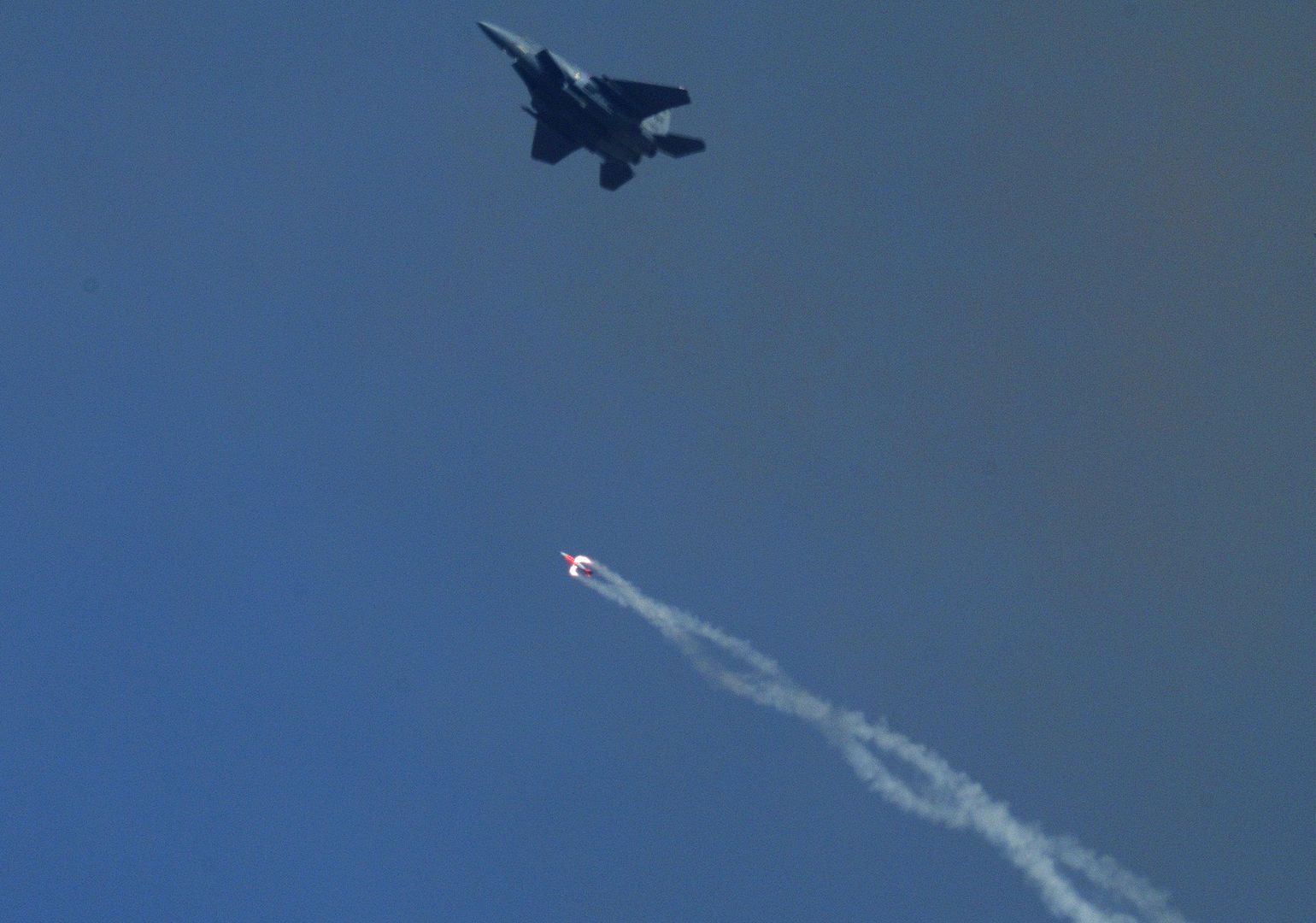
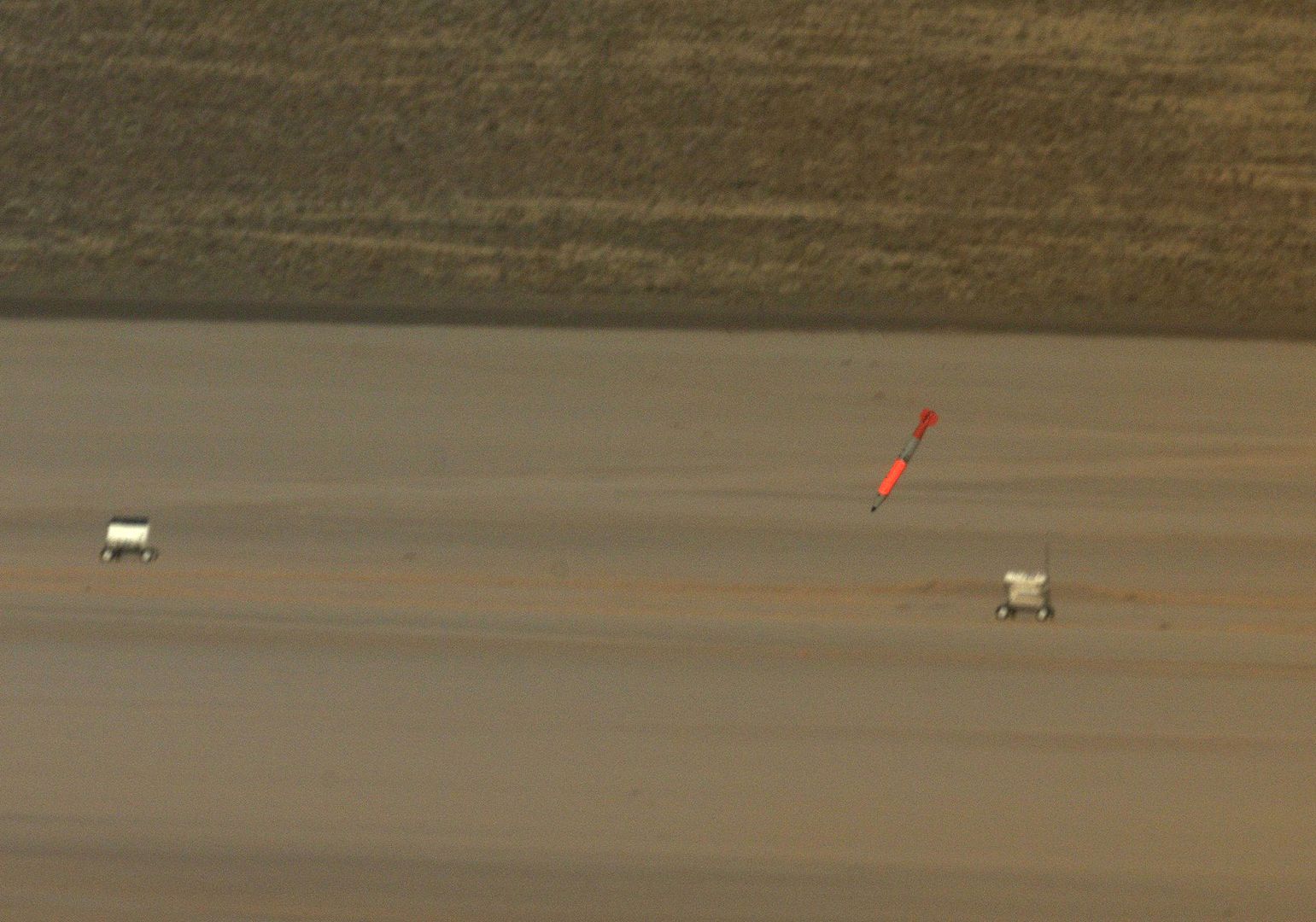
-
9 years agoTue Jul 14 2015, 01:53pm
 Main AdminA Royal Australian Air Force KC-30A Multi Role Tanker Transport refuels an U.S. Navy EA-18G Growler during a refueling training exercise as part of Talisman Sabre 2015 near Darwin, Australia, July 13, 2015. U.S. and Australian forces are conducting air refueling missions throughout the Talisman Sabre 2015 exercise to improve interoperability and familiarization with each other's procedures. Talisman Sabre is a biennial exercise that provides an invaluable opportunity for nearly 30,000 U.S. and Australian defense forces to conduct operations in a combined, joint and interagency environment that will increase both countries? ability to plan and execute a full range of operations from combat missions to humanitarian assistance efforts. (U.S. Air Force photo by Staff Sgt. Alexander Martinez/Released)
Main AdminA Royal Australian Air Force KC-30A Multi Role Tanker Transport refuels an U.S. Navy EA-18G Growler during a refueling training exercise as part of Talisman Sabre 2015 near Darwin, Australia, July 13, 2015. U.S. and Australian forces are conducting air refueling missions throughout the Talisman Sabre 2015 exercise to improve interoperability and familiarization with each other's procedures. Talisman Sabre is a biennial exercise that provides an invaluable opportunity for nearly 30,000 U.S. and Australian defense forces to conduct operations in a combined, joint and interagency environment that will increase both countries? ability to plan and execute a full range of operations from combat missions to humanitarian assistance efforts. (U.S. Air Force photo by Staff Sgt. Alexander Martinez/Released)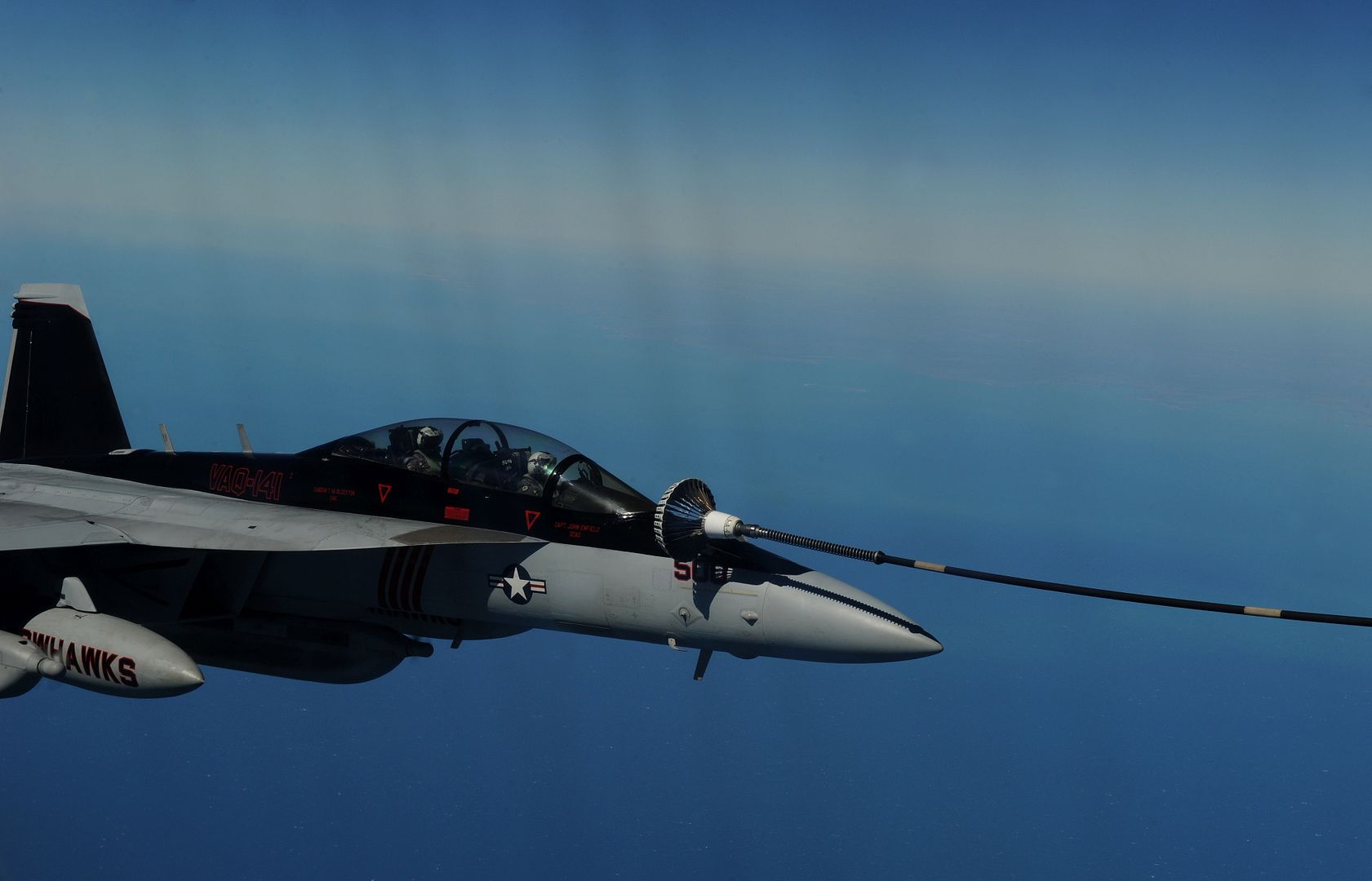
A Royal Australian Air Force KC-30A Multi Role Tanker Transport refuels a RAAF F/A-18 Hornet along side other U.S. and Australian fighters during a refueling training exercise as part of Talisman Sabre 2015 near Darwin, Australia, July 13, 2015. U.S. and Australian forces are conducting air refueling missions throughout the Talisman Sabre 2015 exercise to improve interoperability and familiarization with each other's procedures.Talisman Sabre is a biennial exercise that provides an invaluable opportunity for nearly 30,000 U.S. and Australian defense forces to conduct operations in a combined, joint and interagency environment that will increase both countries? ability to plan and execute a full range of operations from combat missions to humanitarian assistance efforts. (U.S. Air Force photo by Staff Sgt. Alexander Martinez/Released)
A Royal Australian Air Force KC-30A Multi Role Tanker Transport refuels a RAAF F/A-18 Hornet during a refueling training exercise as part of Talisman Sabre 2015 near Darwin, Australia, July 13, 2015. U.S. and Australian forces are conducting air refueling missions throughout the Talisman Sabre 2015 exercise to improve interoperability and familiarization with each other's procedures.Talisman Sabre is a biennial exercise that provides an invaluable opportunity for nearly 30,000 U.S. and Australian defense forces to conduct operations in a combined, joint and interagency environment that will increase both countries? ability to plan and execute a full range of operations from combat missions to humanitarian assistance efforts. (U.S. Air Force photo by Staff Sgt. Alexander Martinez/Released)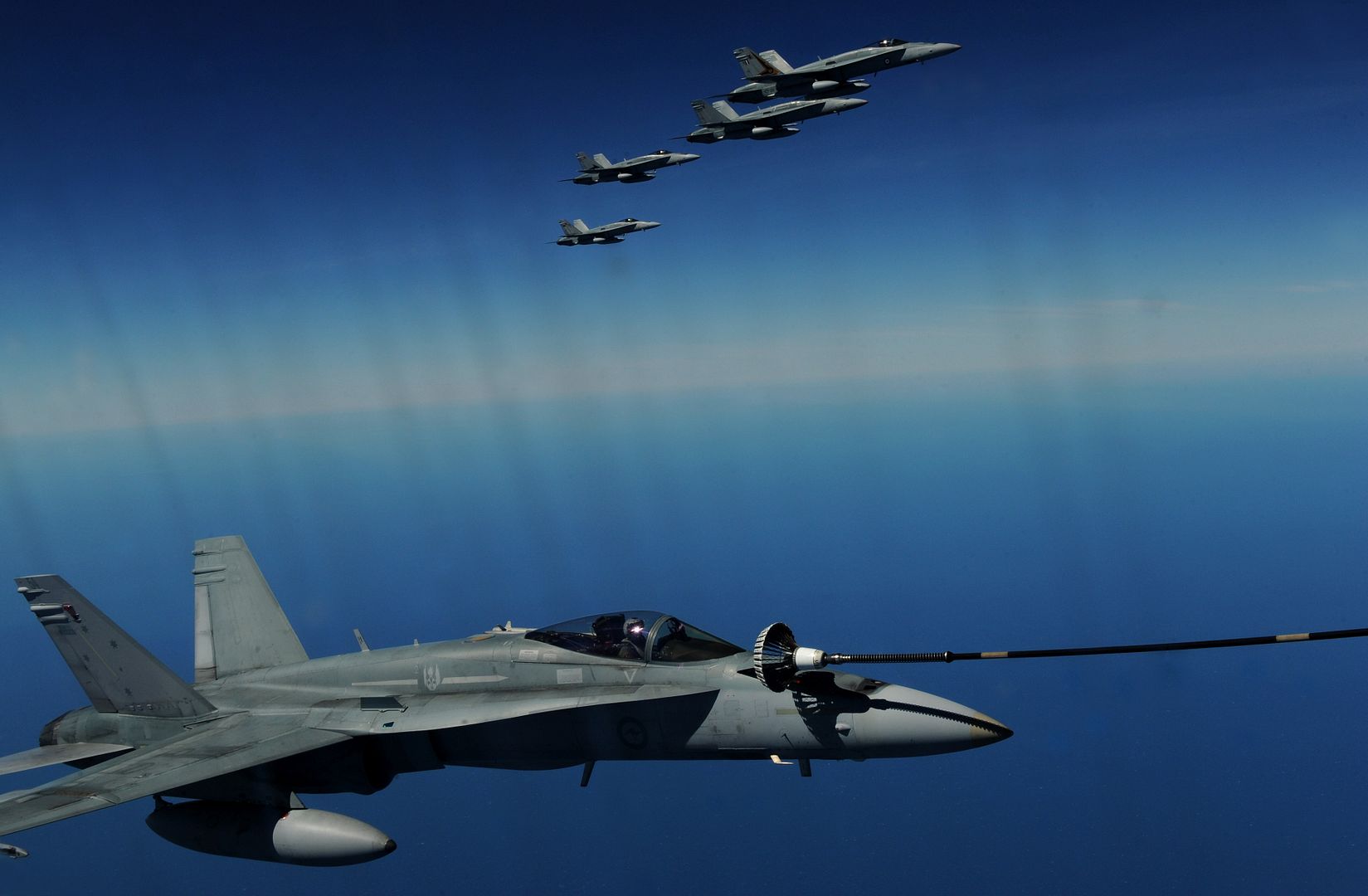
1. Flight tests are over two-thirds complete with no show-stoppers. The Air Force, Marine and Navy variants of the F-35 have each completed at least two-thirds of their flight tests ? over 8,000 are planned ? and no major problems with the design have been identified. All of the key performance parameters for each of the variants have been satisfied, and the plane is flying every day (there have been over 13,000 operational sorties). Tests have validated that the airframe is extremely stealthy ? nearly undetectable by enemy radar ? and that it affords unparalleled situational awareness to pilots.
2. Risks associated with a revolutionary design are being steadily retired. The F-35 is probably the most complicated military-technology project in history. It introduces a host of innovations that have never before been integrated into a combat aircraft. However, developers have successfully resolved every problem that arose with the new technology. For instance, a deficiency in the data that pilots see displayed on the visor of their high-tech helmets has been eliminated; a tailhook on the Navy variant of the fighter that wasn?t consistently grabbing arresting wires was redesigned and now works 100% of the time; a cracked bulkhead discovered during durability testing of the Marine version was strengthened.
3. The Marines will declare initial operational capability this summer. The Marine Corps variant of the F-35, which is capable of vertical takeoff and landing, will officially become operational this summer and begin replacing aged Harrier jump-jets. For the first time ever, the Marines will have a highly survivable, versatile attack aircraft that can land on a dime pretty much anywhere. The Air Force variant will become operational next year, and the Navy variant in 2018. So this isn?t just a development program anymore ? the F-35 has begun to reach the operational force.
4. Sea trials of the Navy version were the most successful ever. According to Navy officials, ?the aircraft demonstrated exceptional performance throughout its initial sea trials.? All of the planned test points were accomplished expeditiously, and Navy testers took the unprecedented step of conducting night operations in the aircraft?s first at-sea trials. The tailhook that is crucial to slowing planes when they hit the carrier deck worked 124 times in 124 attempts ? in other words, flawlessly ? and test pilots described the harrowing experience of final approach as ?carefree? thanks to new technology that captures and maintains an optimum glideslope, substantially reducing pilot workload and enhancing safety.
5. Over 145 F-35s have been built and delivered. After seven successive production lots, key manufacturing processes have been refined in preparation for a steady ramp-up of output. A total of 88 F-35s are currently under construction at Lockheed Martin?s plant in Fort Worth, and 110 are being produced worldwide. There has been a 68% reduction in the labor hours required to assemble each plane since the initial production lot, and an 82% reduction in scrap, rework and repair. The cost of building an F-35 is falling in each successive production lot, and the price-tag for the most common, Air Force, variant looks likely to match that of last-generation fighters by the end of the decade.
6. Estimates of life-cycle costs are falling fast. The joint program office?s projection of what it will cost to sustain the F-35 during a 55-year service life fell by $58 billion in its most recent estimates. The official estimate of what it will cost to support all 2,457 U.S. F-35s remains unchanged because the Pentagon?s cost-assessment shop does not adjust its projections between program milestones, but that will change when the next milestone is reached in 2017. In the meantime, the joint program office ? which is not similarly constrained ? says the projected cost of operating the plane is falling due to a better understanding of fuel consumption, maintenance needs, labor rates and the like.
7. Numerous allies have joined the F-35 program. The F-35 program from its inception has been a joint effort by three U.S. military services and eight international partners. The foreign partners ? Australia, Britain, Italy and others ? collectively have contributed nearly $5 billion to the plane?s development. Their participation in the production program is expected to save U.S. taxpayers $36 billion by fostering economies of scale. And now other countries are signing up, including Israel, Japan and South Korea. The participation of so many key allies in the F-35 effort will enhance interoperability and minimize fratricide in future coalition air operations.
8. Nearly 200 pilots and 2,000 maintainers have been trained. Program managers are steadily expanding the joint infrastructure that will support the fielded force of F-35s. There are a total of nine operating bases where over 145 planes are operating, and the program has surpassed 35,000 flight hours. Training personnel ? I have talked to several ? are uniformly positive in praising the aircraft?s handling characteristics, reliability and maintainability. The stealth features of the F-35 were designed to be more easily maintained than low observables on earlier planes, a key consideration in managing life-cycle costs.
9. There is better understanding of fifth-generation fighters. The F-35 program has been dogged from its early days by the secrecy surrounding much of what makes it unique. Experts use the shorthand term ?fifth-generation? to describe the unique combination of stealth, sensor fusion, networking and other features that will make it the most formidable tactical aircraft in history, but it has taken time for people to grasp the operational implications (one recent story noted the complaint of a test pilot who said he couldn?t turn his head to see where an adversary was behind him ? something pilots wouldn?t do in a fully-equipped F-35). As more and more pilots actually fly the plane though, the logic of its design and features is becoming obvious.
10. The political system has closed ranks behind the program. It isn?t just the pilots who have begun to appreciate what an F-35 can accomplish. Pentagon officials and members of Congress who once were critical of F-35 are now highlighting how the program has overcome developmental challenges to deliver a truly impressive product. Senior military officers who seemed ambivalent in the past are now supportive, acquisition officials are citing steady programmatic progress, and even Senator McCain has become more positive in his assessment of the effort. That doesn?t mean the program will encounter no further setbacks, but what it does signal is that the F-35 effort is in better shape today than ever before ? which is a good thing, because there is no ?Plane B? waiting in the wings.
The 391st Fighter Squadron flagship F-15E Strike Eagle taxies off the runway at Nellis Air Force Base, Nev., July 7, 2015. Red Flag 15-3 is a realistic combat training exercise involving the air forces of the United States and its allies. The exercise is conducted on the 15,000-square-mile Nevada Test and Training Range, located north of Las Vegas. (U.S. Air Force photo by Senior Airman Brittany A. Chase)
75 years after the start of the Battle of Britain, the RAF marked the anniversary today [Friday, 10 July] with an enhanced Change of the Guard and a flypast in front of The Queen and six Battle of Britain veterans at Buckingham Palace.
-
9 years agoWed Jul 15 2015, 03:23pm
 Main Admin
Main Admin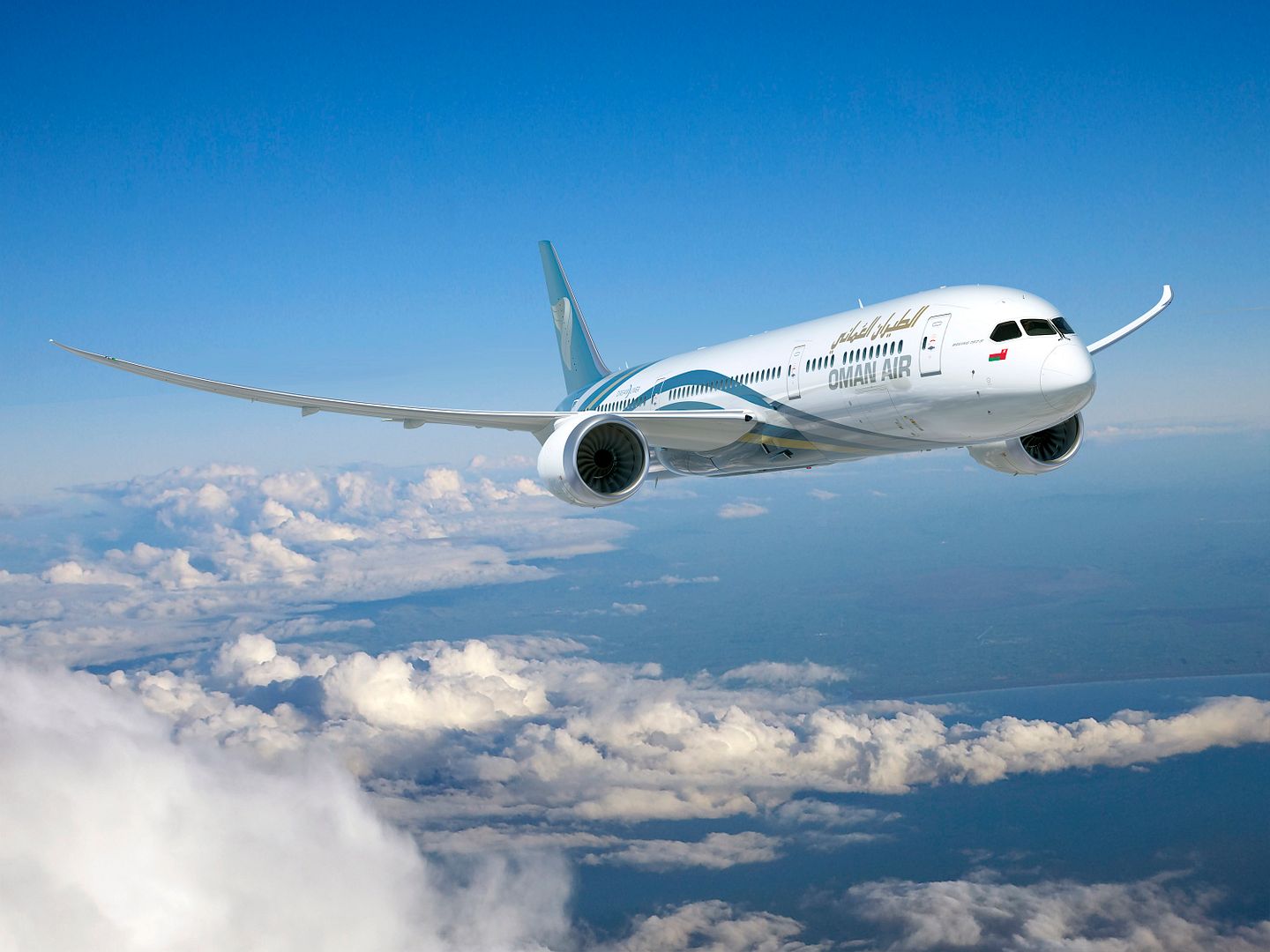
SEATTLE, July 14, 2015 /PRNewswire/ -- Boeing [NYSE: BA] announced today that Oman Air has contracted for a suite of services to support the upcoming entry into service of the airline's 787 Dreamliners and to ensure ongoing efficiency and cost savings for its fleet.
"Boeing's industry-leading services will ensure a smooth introduction of our 787s while controlling costs, minimizing component maintenance time and optimizing our fleet's performance," said Salim Al Kindy, Chief Technical Officer, Oman Air. "This falls in line with our Shape and Size concept, as we continue to expand our global presence with a young, state of the art fleet of aircraft. This extremely high level of technical support, combined with an award winning service, ensures we continue to stay ahead of our customers' expectations."
Boeing will support Oman Air's 787s with its Component Services (formerly Rotables Exchange) program, Loadable Software Airplane Parts service and Airplane Health Management. Together, these services will help Oman Air minimize the time and cost of maintenance while increasing airplane availability.
With the Component Services program, Oman Air will have access to a Boeing-managed, dedicated pool of high-value, mission-critical parts, enabling the airline to greatly reduce their inventory management costs while improving component availability.
Through the Loadable Software Airplane Parts service, Boeing will handle software configuration and management tasks associated with operating the 787.
Airplane Health Management will allow Oman Air to minimize maintenance delays and schedule disruptions by continuously monitoring airplane performance while the airplane is in flight, notifying ground crews in advance of potential maintenance issues.
"Boeing services are a simple way for airlines to reduce the total cost of airplane ownership, giving them a competitive advantage in their markets," said Marty Bentrott, senior vice president, Sales for Russia, Middle East and Central Asia, Boeing Commercial Airplanes. "We look forward to helping ensure our key customer and partner Oman Air is successful as they begin operating this revolutionary airplane."
Oman Air, the designated carrier of the Sultanate of Oman, has six 787s on order.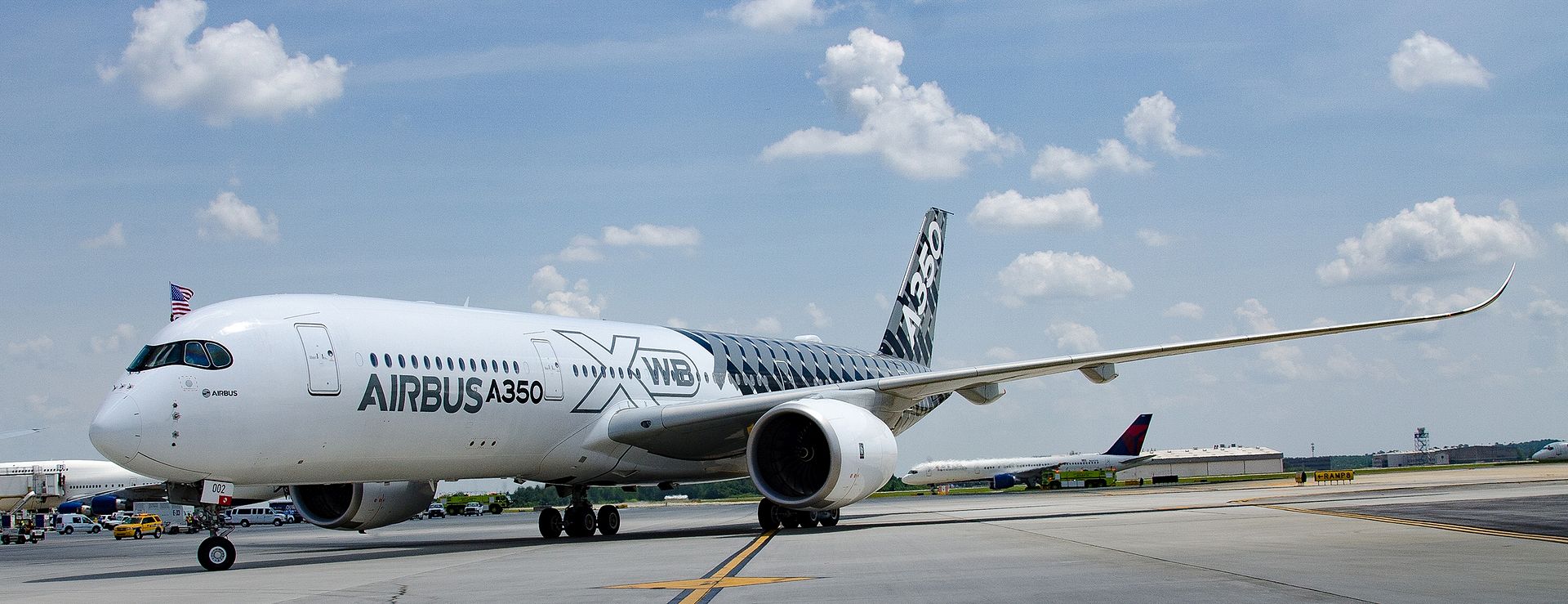
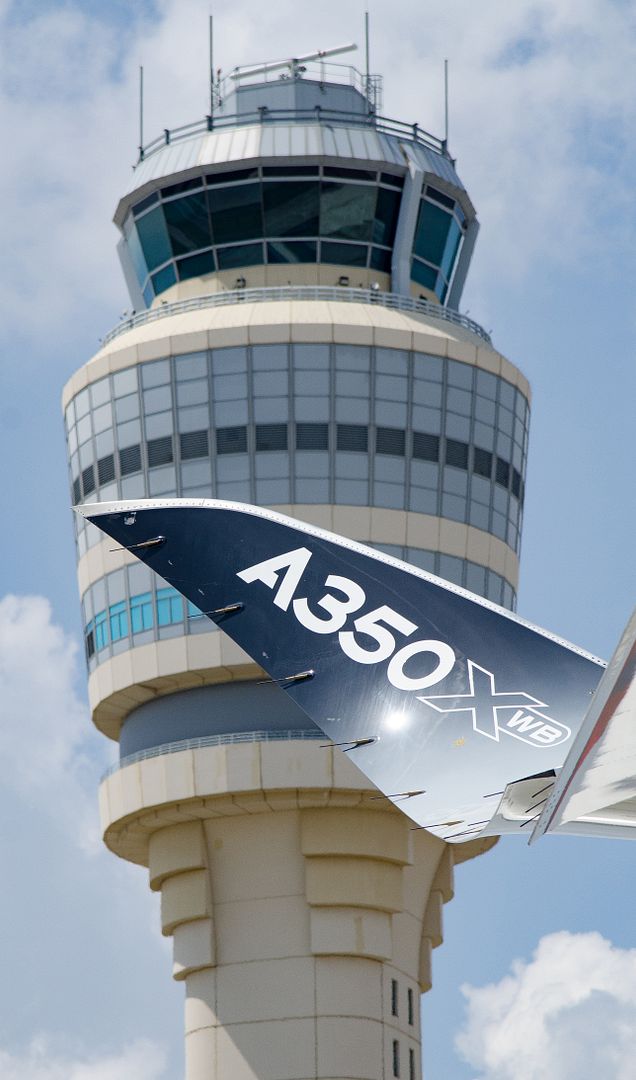
14 July 2015 Press Release
As it touched down in Atlanta, the newest commercial aircraft in the world, the Airbus A350 XWB, kicked off the U.S. leg of its tour of the Americas. The demo tour features a flight test version of the aircraft, which Airbus is showing off to investors and airlines in Atlanta, Newark, Chicago and Milwaukee before the general public can experience the A350 XWB at EAA?s AirVenture air show in Oshkosh, Wisconsin.
While it is in Atlanta, Delta Air Lines employees will tour the aircraft, familiarizing themselves with its layout and features. For many of them it will be their first opportunity to get a closer look at what will become the newest member of its fleet in 2017, when Delta accepts the first delivery of its 25 A350 XWBs. Delta currently operates Airbus A319, A320 and A330 aircraft, with additional outstanding orders for each type.
The A350-900 that is in the U.S. this week is a flight test aircraft featuring a two-class cabin. It seats 42 in lie-flat, business-class seats, which are four abreast, and 210 economy-class seats. For passengers, the aircraft will provide new levels of comfort, with extra space in all classes. It features wider panoramic windows, larger overhead stowage compartments and the latest in-flight entertainment and connectivity.
The A350 XWB also features the latest in aerodynamic design, carbon-fiber fuselage and wings, and new fuel-efficient Rolls-Royce Trent XWB engines. These technologies translate into a 25-percent reduction in fuel burn and emissions as well as lower maintenance costs.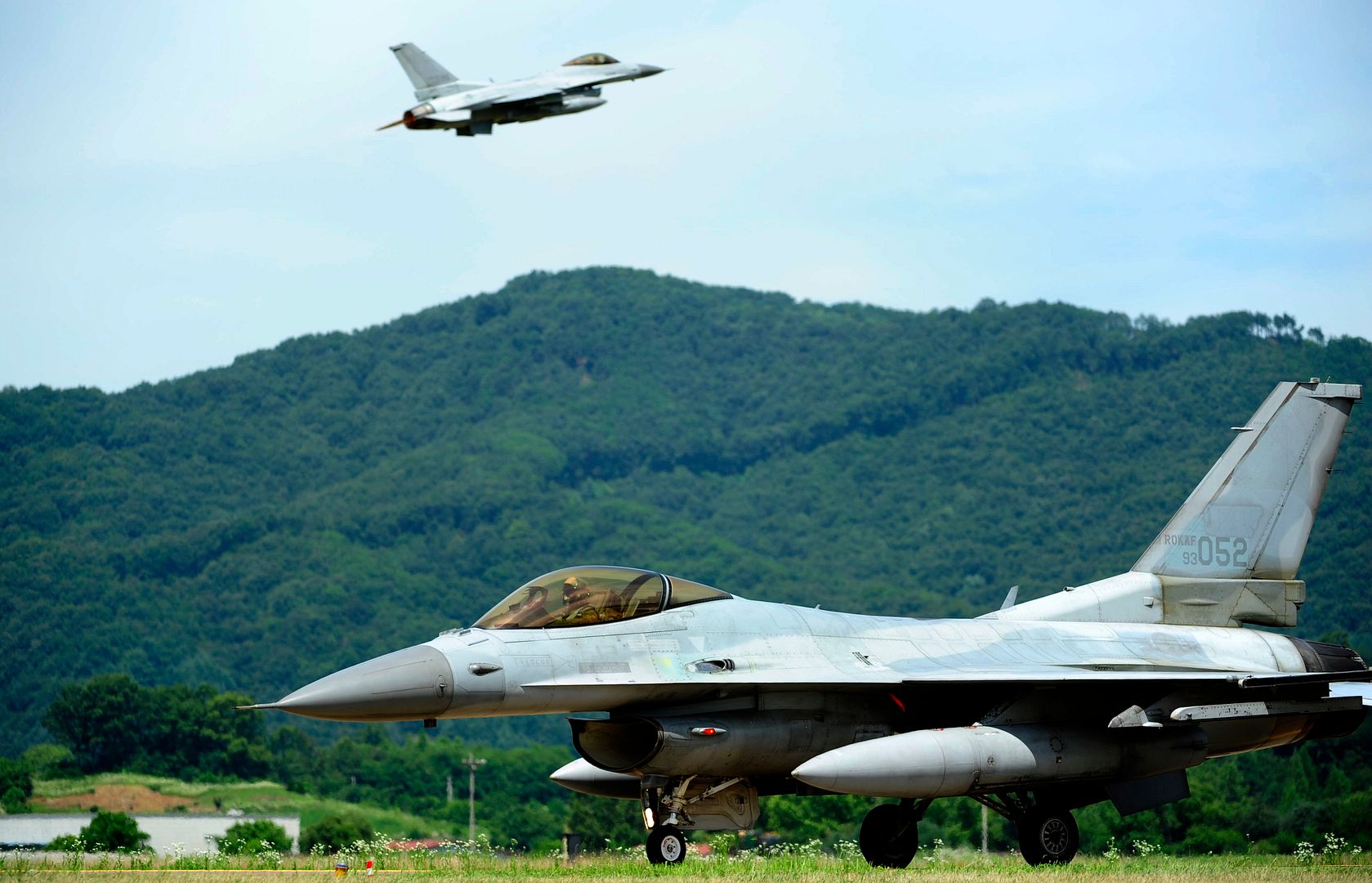
A South Korean air force KF-16 Fighting Falcon from the 19th Fighter Wing taxis on the runway at Jungwon Air Base, South Korea, during Buddy Wing 15-6, July 10, 2015. Buddy Wing exercises are conducted multiple times throughout the year to sharpen interoperability between U.S. and South Korean forces so, if the need arises, they are always ready to fight as a combined force. (U.S. Air Force photo/Staff Sgt. Nick Wilson)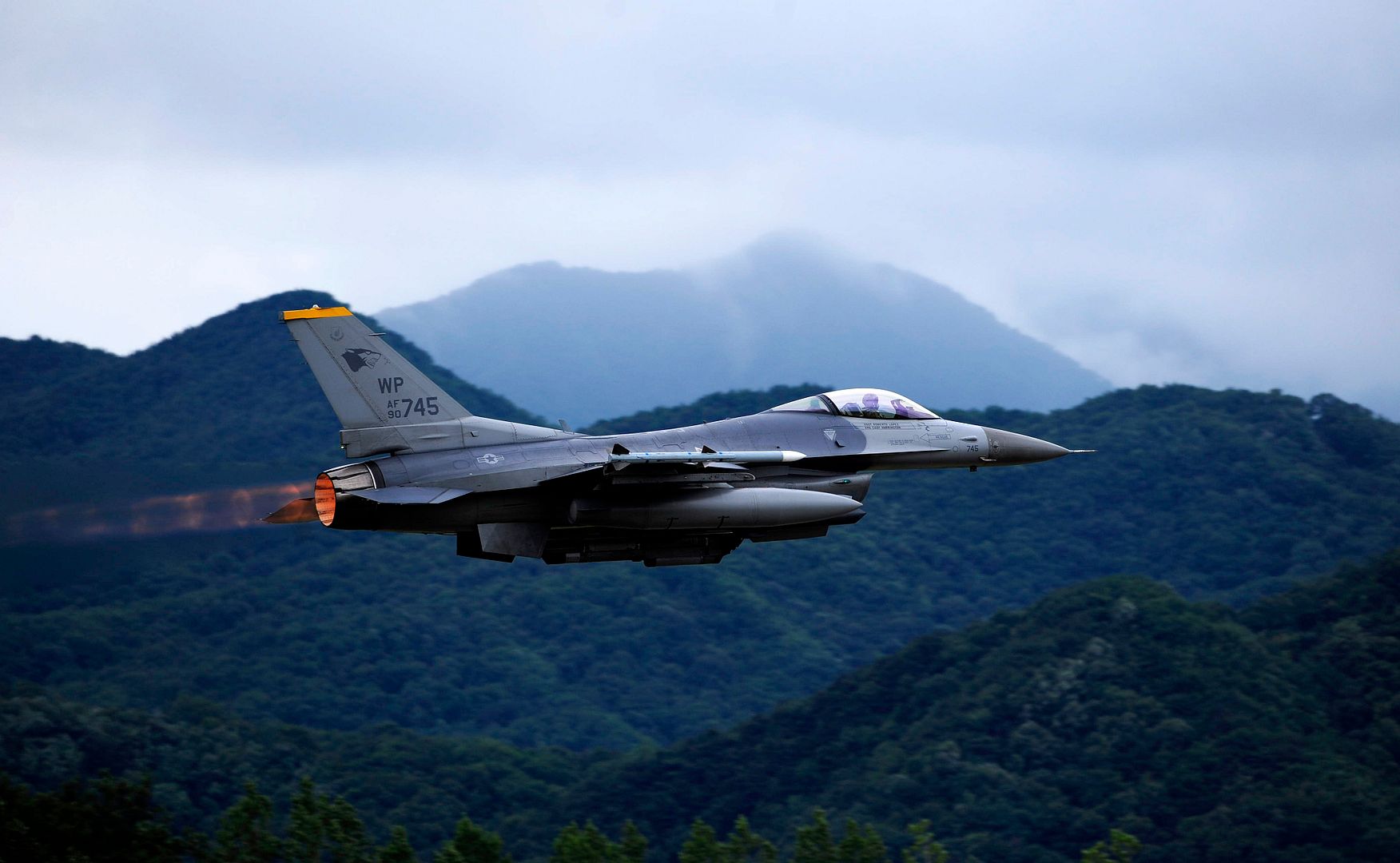
An F-16 Fighting Falcon from the 80th Fighter Squadron at Kunsan Air Base, South Korea, takes off at Jungwon AB, South Korea, during Buddy Wing 15-6, July 8, 2015. Buddy Wing exercises are conducted multiple times throughout the year to sharpen interoperability between U.S. and South Korean forces so, if the need arises, they are always ready to fight as a combined force. (U.S. Air Force photo/Staff Sgt. Nick Wilson)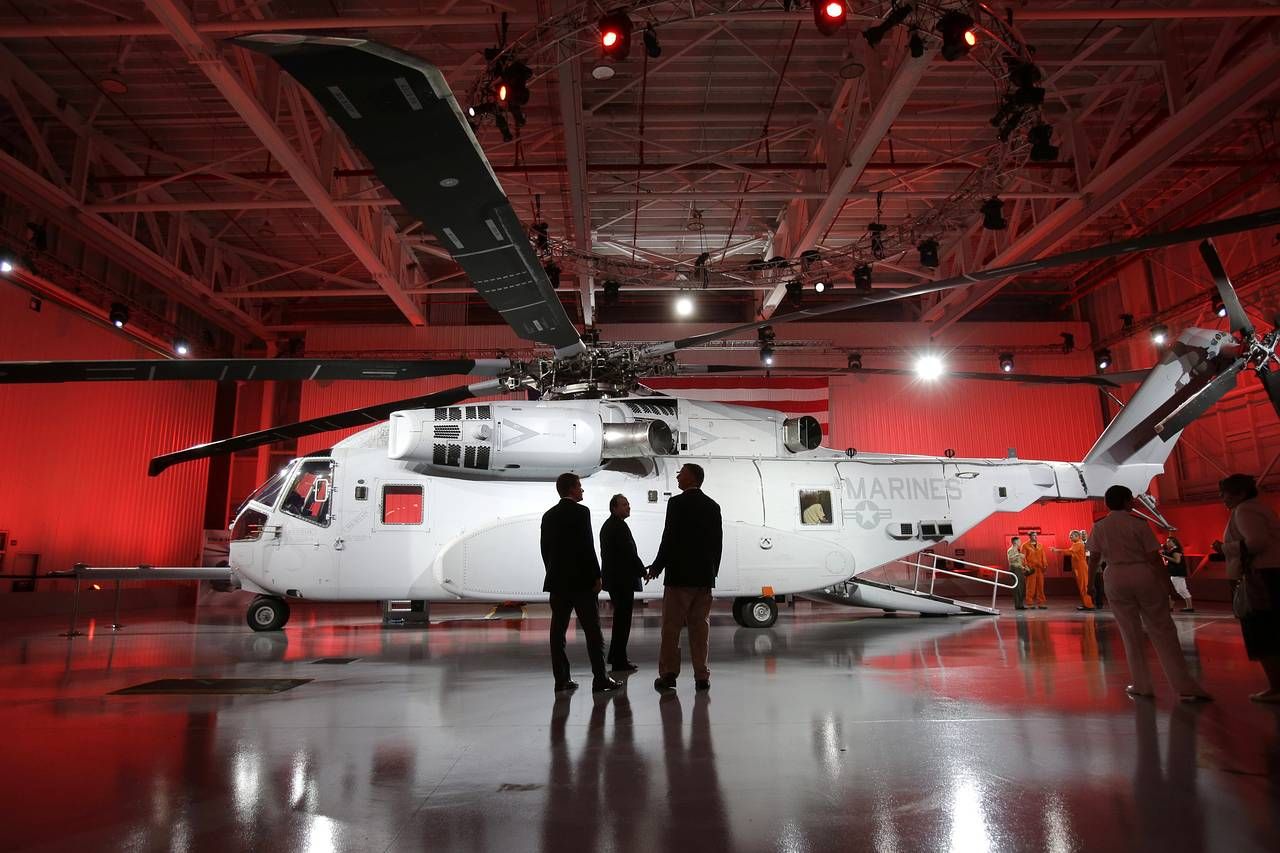
July 14, 2015
Sikorsky Aircraft Corp. has been forced to delay the first flight of its largest helicopter until later this year while it completes testing fixes to its gearbox and other problems, the U.S. Navy said Tuesday.
Navy program officials said they have resolved the gearbox problems that have contributed to delays in the new CH-53K King Stallion heavy-lift helicopter that was due to fly for the first time in June 2014, but these still require additional testing.
The U.S. Marine Corps plans to buy 200 of the helicopters, a $25.5 billion program that accounts for half of Sikorsky?s existing commitments from the Pentagon.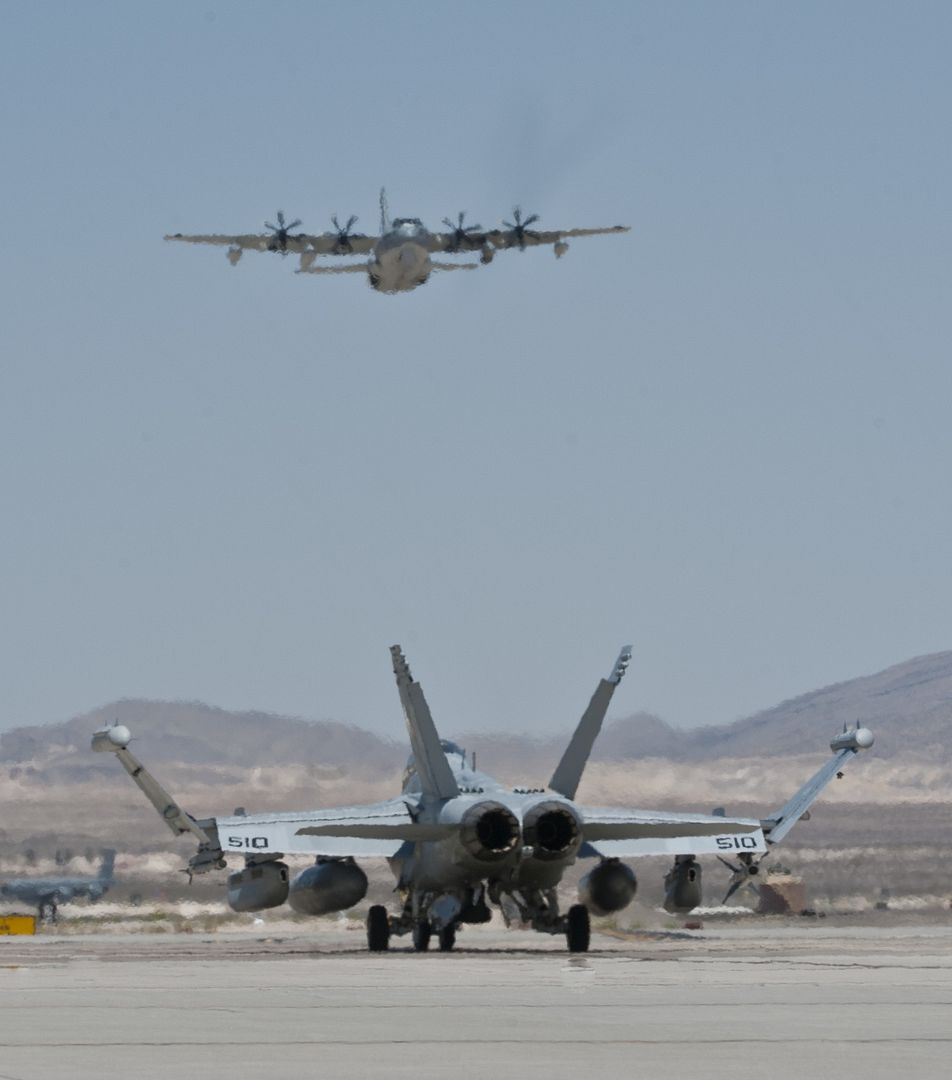
An EA-18G Growler taxis down the flightline during Red Flag 15-03 at Nellis Air Force Base, Nev., July 13, 2015. Since its establishment in 1975, Red Flag participants have used the 2.9 million acre Nevada Test and Training Range as a one-of-a-kind arena for realistic air combat training.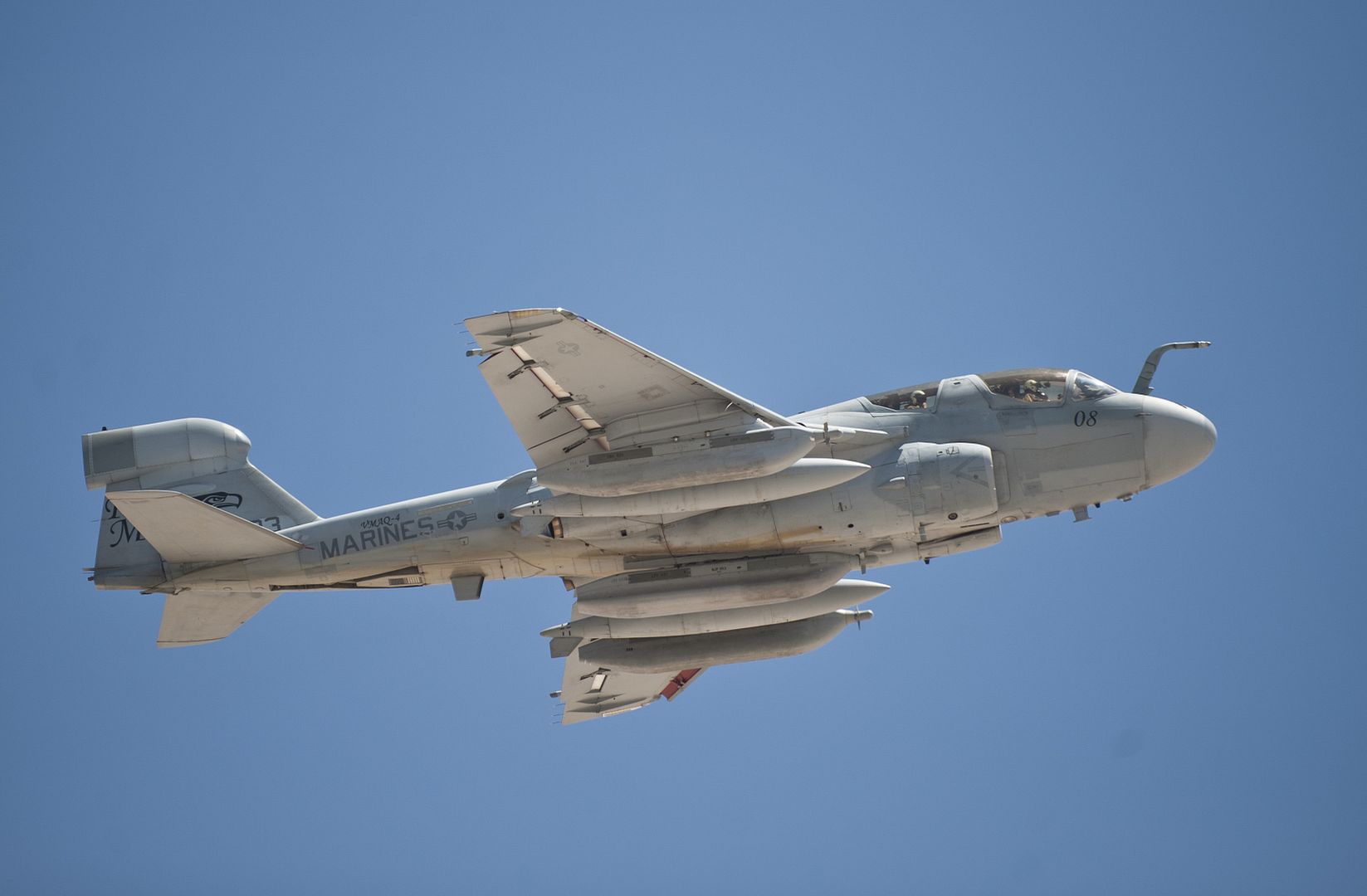
An EA-6B Prowler assigned to Marine Tactical Electronic Warfare Squadron 4, Marine Corps Air Station Cherry Point, N.C., flies during a Red Flag 15-3 sortie at Nellis Air Force Base, Nev., July 13, 2015. Red Flag provides realistic combat training in a contested, degraded and operationally-limited environment.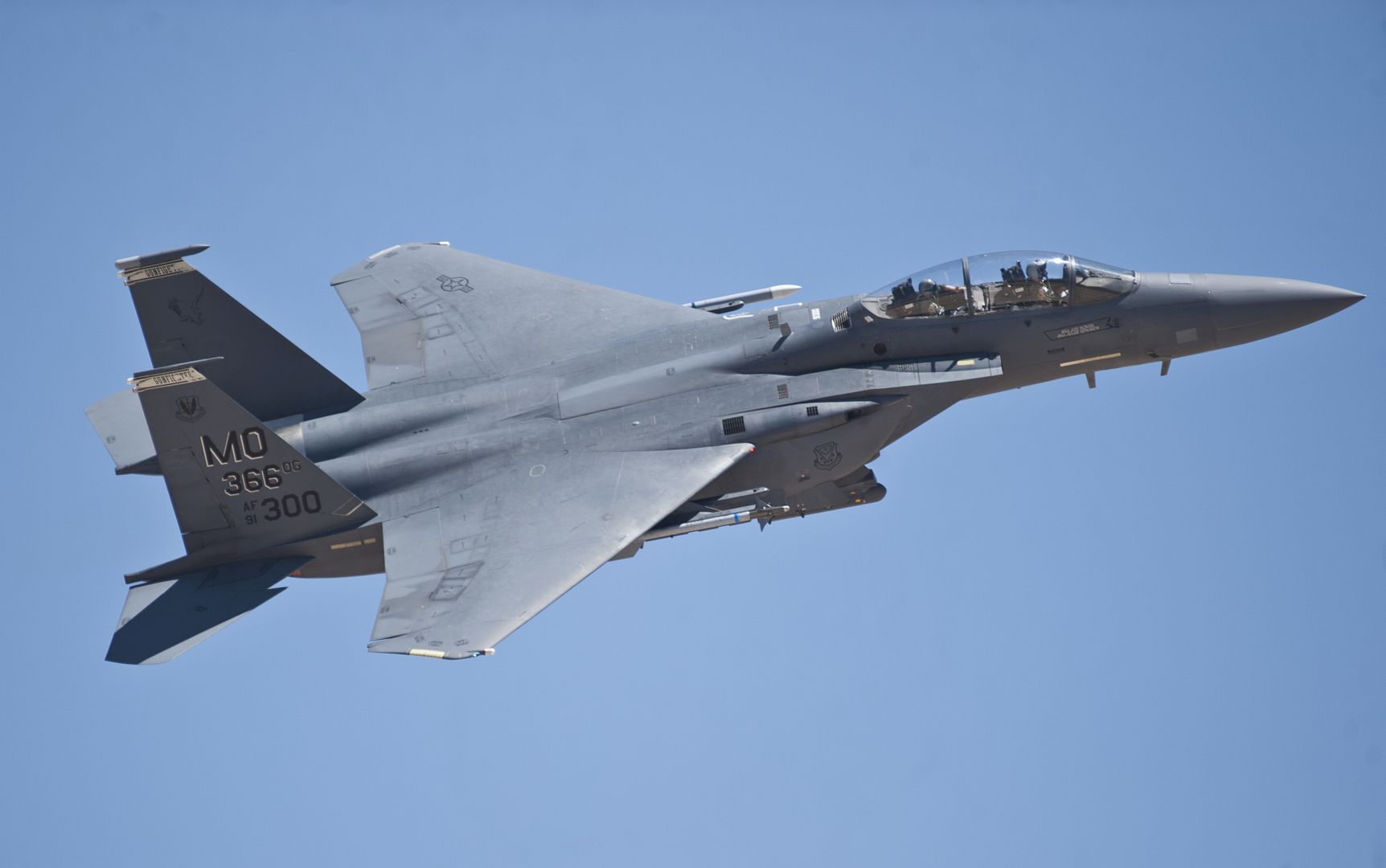
An F-15E Strike Eagle assigned to Mountain Home Air Force Base, Idaho, flies during a Red Flag 15-3 sortie at Nellis Air Force Base, Nev., July 13, 2015. The 366th Fighter Wing, assigned to Mountain Home AFB, is the lead wing of Red Flag 15-3 which is designed to provide a series of intense air-to-air combat scenarios for aircrew and ground personnel which will increase their combat readiness and effectiveness for future real-world missions. -
 Main AdminA U.S. Air Force KC-10 Extender from the 2nd Air Refueling Squadron (2nd ARS) stationed at Joint Base McGuire-Dix-Lakehurst, New Jersey, conducts refueling operations with an F/A-18 Hornet during a refueling training exercise as part of Talisman Sabre 2015 near Darwin, Australia, July 15, 2015. U.S. and Australian forces are conducting air refueling missions throughout the Talisman Sabre 2015 exercise to improve interoperability and familiarization with each other's procedures. Talisman Sabre is a biennial exercise that provides an invaluable opportunity for nearly 30,000 U.S. and Australian defense forces to conduct operations in a combined, joint and interagency environment that will increase both countries? ability to plan and execute a full range of operations from combat missions to humanitarian assistance efforts.
Main AdminA U.S. Air Force KC-10 Extender from the 2nd Air Refueling Squadron (2nd ARS) stationed at Joint Base McGuire-Dix-Lakehurst, New Jersey, conducts refueling operations with an F/A-18 Hornet during a refueling training exercise as part of Talisman Sabre 2015 near Darwin, Australia, July 15, 2015. U.S. and Australian forces are conducting air refueling missions throughout the Talisman Sabre 2015 exercise to improve interoperability and familiarization with each other's procedures. Talisman Sabre is a biennial exercise that provides an invaluable opportunity for nearly 30,000 U.S. and Australian defense forces to conduct operations in a combined, joint and interagency environment that will increase both countries? ability to plan and execute a full range of operations from combat missions to humanitarian assistance efforts.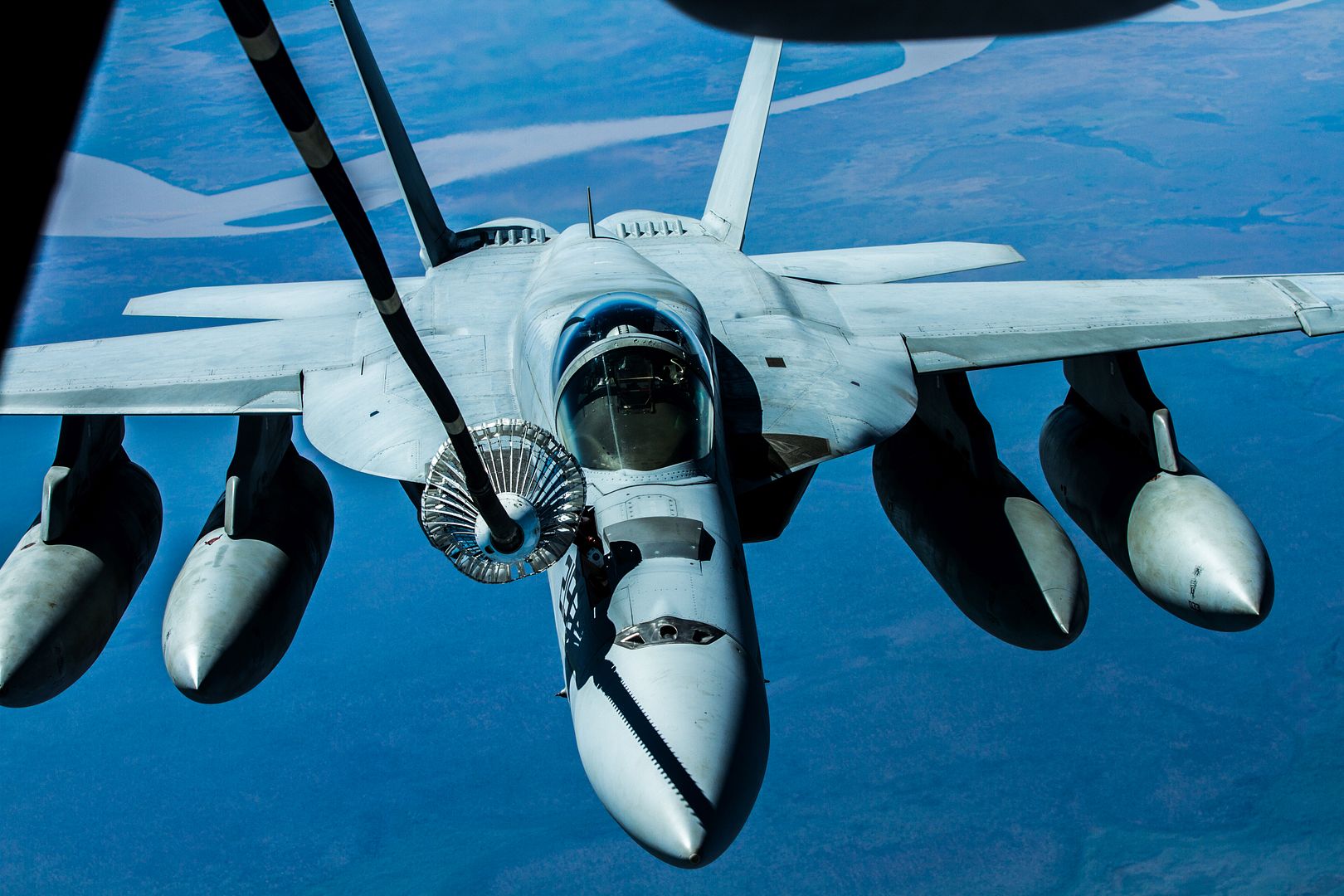
A Royal Australian Air Force KC-30A Multi Role Tanker Transport refuels a RAAF F/A-18 Hornet during a refueling training exercise as part of Talisman Sabre 2015 near Darwin, Australia, July 15, 2015. U.S. and Australian forces are conducting air refueling missions throughout the Talisman Sabre 2015 exercise to improve interoperability and familiarization with each other's procedures. Talisman Sabre is a biennial exercise that provides an invaluable opportunity for nearly 30,000 U.S. and Australian defense forces to conduct operations in a combined, joint and interagency environment that will increase both countries? ability to plan and execute a full range of operations from combat missions to humanitarian assistance efforts.
CAPE CANAVERAL AIR FORCE STATION, Fla., July 15, 2015 ? The 10th Boeing [NYSE: BA] GPS IIF satellite has reached orbit and sent its first signals after being launched earlier today. This satellite advances the U.S. Air Force?s modernization program for GPS, improving accuracy and enhancing security for the navigation system used by millions of people around the world every day.
The Boeing-built GPS IIFs are the newest generation of GPS satellites, delivering a longer design life, greater accuracy, increased signal power for civil applications, a more robust military M-code signal and variable power for better jamming resistance. The IIFs also are outfitted with the new civilian L-5 signal which, when fully operational, will be used for emergency applications.
"The GPS IIF-10 launch milestone continues a series of recent unparalleled successes for the GPS IIF program,? said Dan Hart, vice president, Boeing Government Space Systems. ?We understand the importance of this system to the global community, both civil and military, and the government-Boeing team is partnering to assure mission success and operational excellence."
GPS IIF-10 lifted off from Cape Canaveral Air Force Station aboard a United Launch Alliance Atlas V expendable launch vehicle at 11:36 a.m. EDT. About three hours and 23 minutes later, the spacecraft was released into its medium earth orbit of about 12,000 miles.
Boeing will support the Air Force in performing on-orbit checkout of GPS IIF-10 before it is formally declared operational in about one month. The next GPS satellite, GPS IIF-11, was shipped to Cape Canaveral on June 8 in preparation for the third and final IIF launch of 2015 later this fall.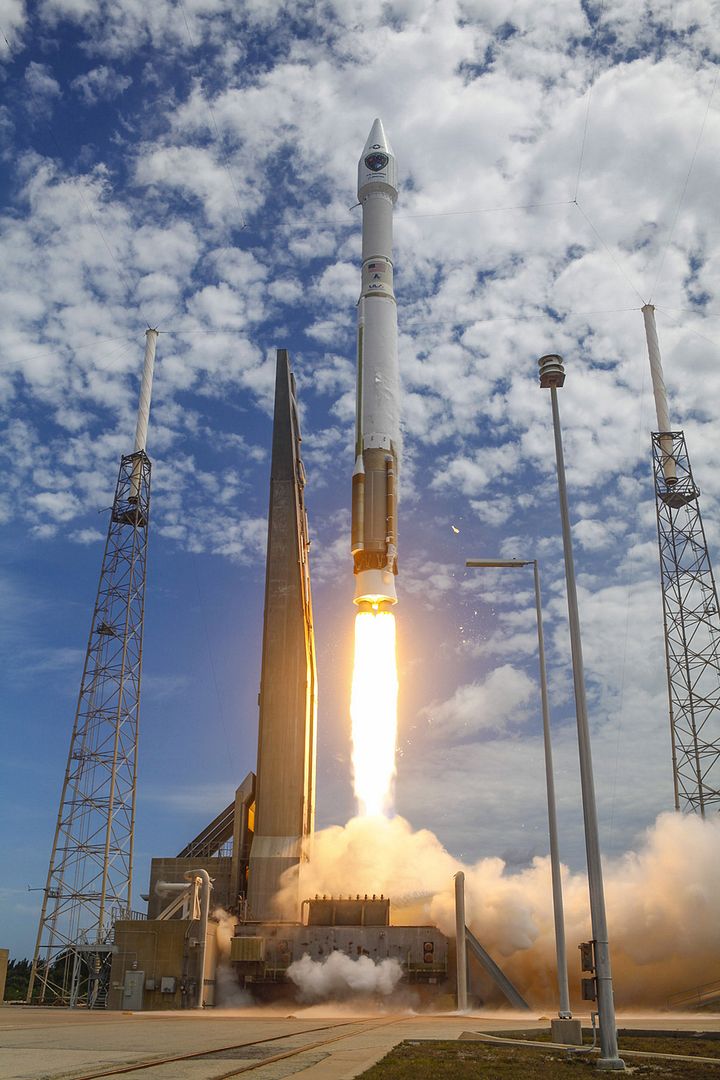
July 15th press release.
Airbus Defence and Space has successfully completed flight-testing of a package of aerodynamic upgrades to the Eurofighter Typhoon swing-role fighter that promises to enhance further the aircraft?s agility and weapons-carrying ability.
The Aerodynamic Modification Kit (AMK) is part of a wider Eurofighter Enhanced Manoeuvrability (EFEM) programme with the potential to help ensure the type?s continuing superiority for many years to come.
It entails primarily the addition of fuselage strakes and leading-edge root extensions, which increase the maximum lift created by the wing by 25% - resulting in an increased turn rate, tighter turning radius, and improved nose-pointing ability at low speed ? all critical fighter capabilities in air-to-air combat.
The introduction of the AMK will not only enhance the Eurofighter?s current capability as a swing-role fighter-bomber, but will provide additional growth potential, enabling easier integration of future air?to-surface configurations and much more flexible applications, vastly enhancing the aircraft?s mission effectiveness in the air-to-surface role.
Eurofighter Project Pilot Germany Raffaele Beltrame said: ?This programme has been a tremendous success with very impressive results ? in some areas even better than we expected.
?We saw angle of attack values around 45% greater than on the standard aircraft, and roll rates up to 100% higher, all leading to increased agility. The handling qualities appeared to be markedly improved, providing more manoeuvrability, agility and precision while performing tasks representative of in-service operations. And it is extremely interesting to consider the potential benefits in the air-to-surface configuration thanks to the increased variety and flexibility of stores that can be carried.
?It?s right to say that the EFEM/AMK work has allowed us to discover a new aircraft with much higher performance and greater potential to meet the challenges of the years ahead.?
The flight trials followed some five years of studies. Eurofighter test pilots, joined in the latter stages by operational pilots from Germany, Italy and the UK, completed 36 sorties from Manching, Germany on the IPA7 Instrumented Production Aircraft.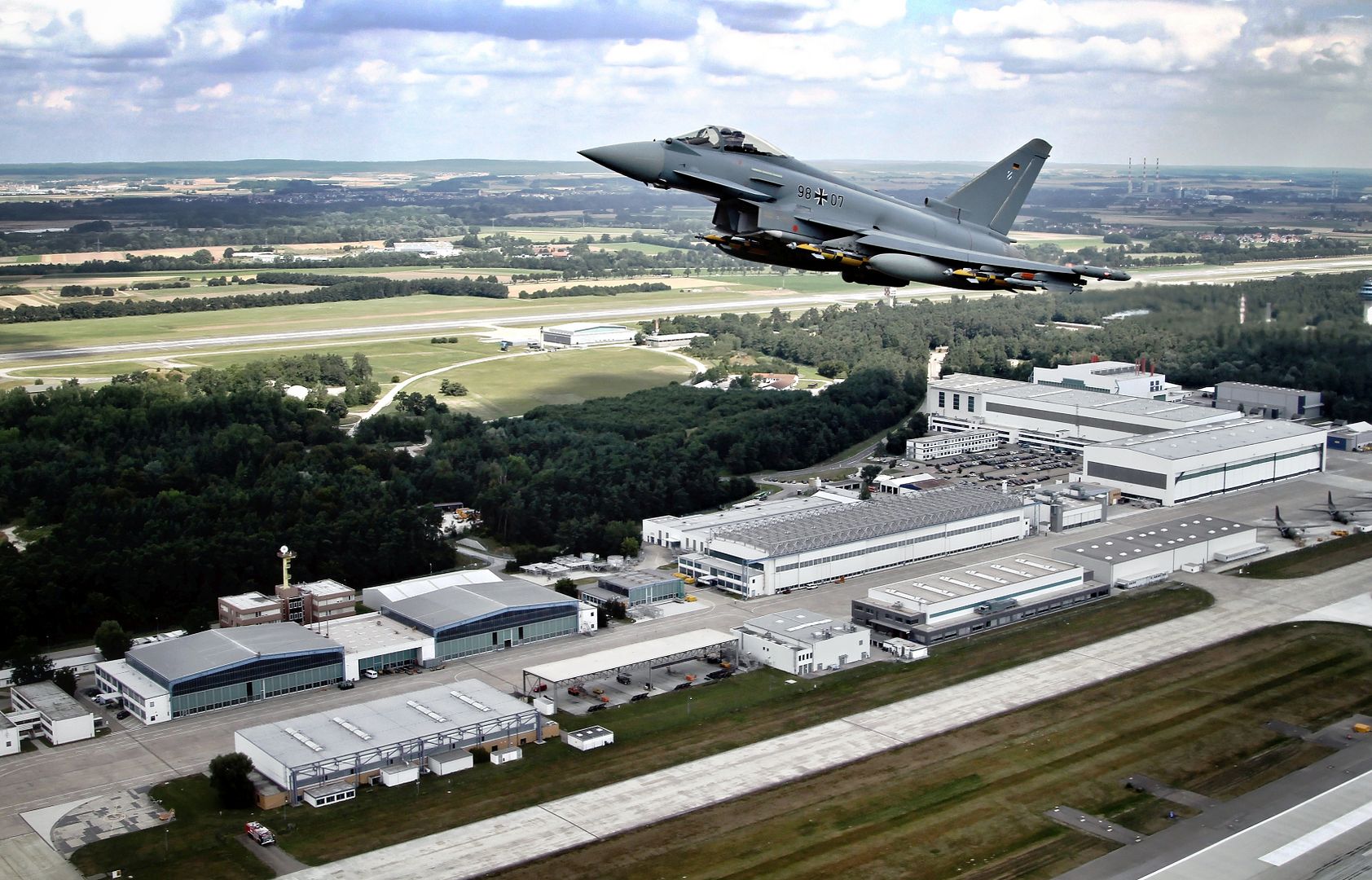
-
 Main AdminJuly 16th
Main AdminJuly 16th
1 (Fighter) Squadron has helped to launch a commemorative set of six stamps by Royal Mail in order to celebrate the 75th Anniversary of the Battle of Britain.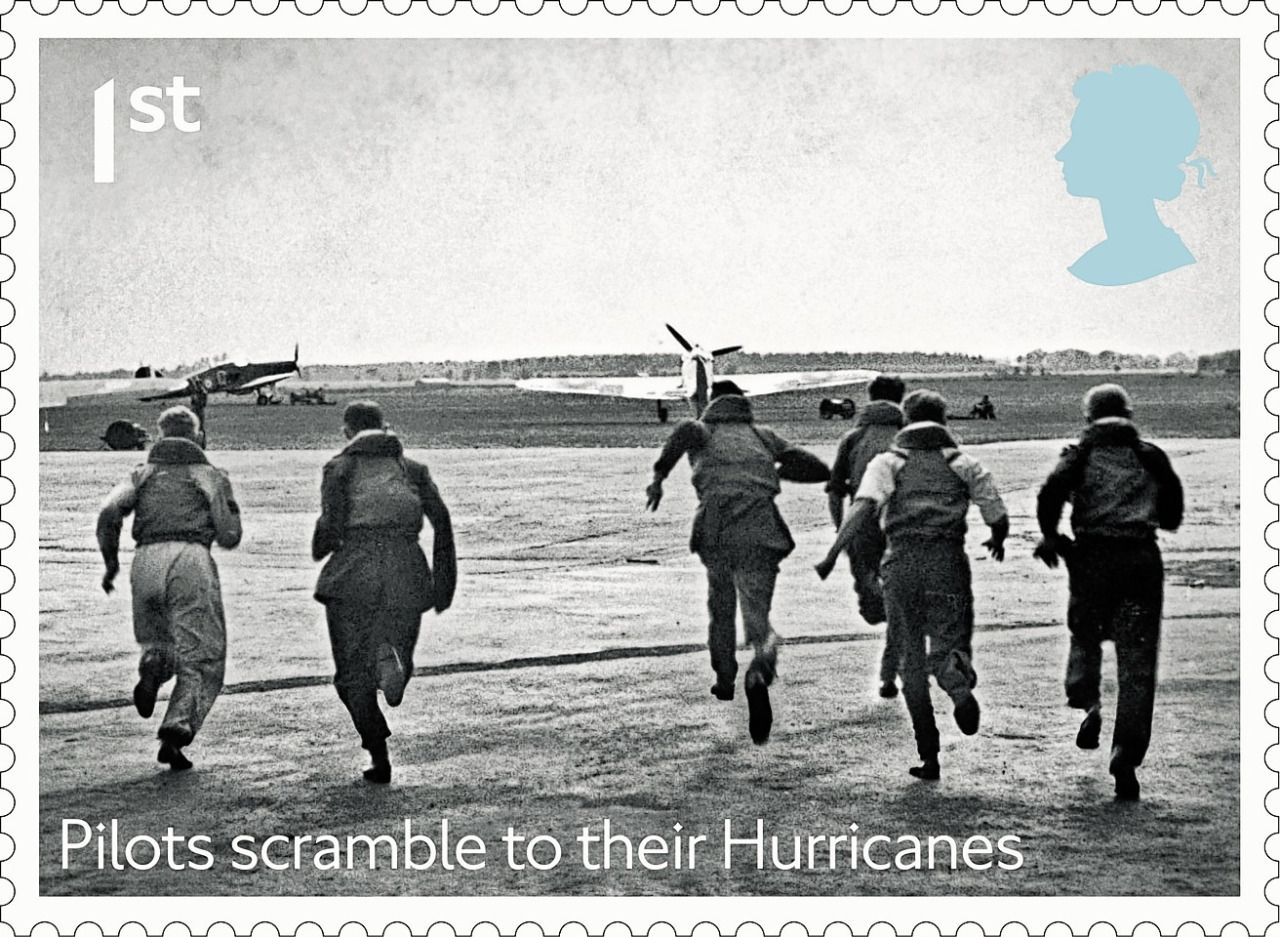
The Battle of Britain was a crucial factor in deciding the outcome of the war, with 1 (Fighter) Squadron making a significant contribution. The battle began in July 1940 with German attacks on convoys and ports, designed to prime Britain for a Nazi invasion.The RAF?s fighter command had only 715 aircraft against the Luftwaffe?s 2,250, but its ferocious response forced Hitler to abandon his invasion plans that September.
The efforts of the pilots who flew during the Battle of Britain led then-prime minister Winston Churchill to famously remark: ?Never in the field of human conflict was so much owed by so many to so few.?
Royal Mail is also marking the campaign?s anniversary by postmarking all mail stamped from today until Saturday with the phrase ?75th anniversary Battle of Britain?.
Wing Commander Michael 'Sooty' Sutton, Officer Commanding 1 (Fighter) Squadron, met local postman Ross Farquhar at RAF Lossiemouth yesterday to mark the launch of the stamps. He said:
?It is always a humbling experience and source of great pride to look back and recognise the sacrifice of my predecessors on 1 (Fighter) Squadron, as well as all the men and women who took part in the Battle of Britain 75 years ago. The images used by Royal Mail for their commemorative stamps can only allude to the impressive efforts by the Royal Air Force in Britain?s darkest hour.?
It follows an anniversary flypast by a Typhoon from 1(F) squadron over Buckingham Palace on Sunday.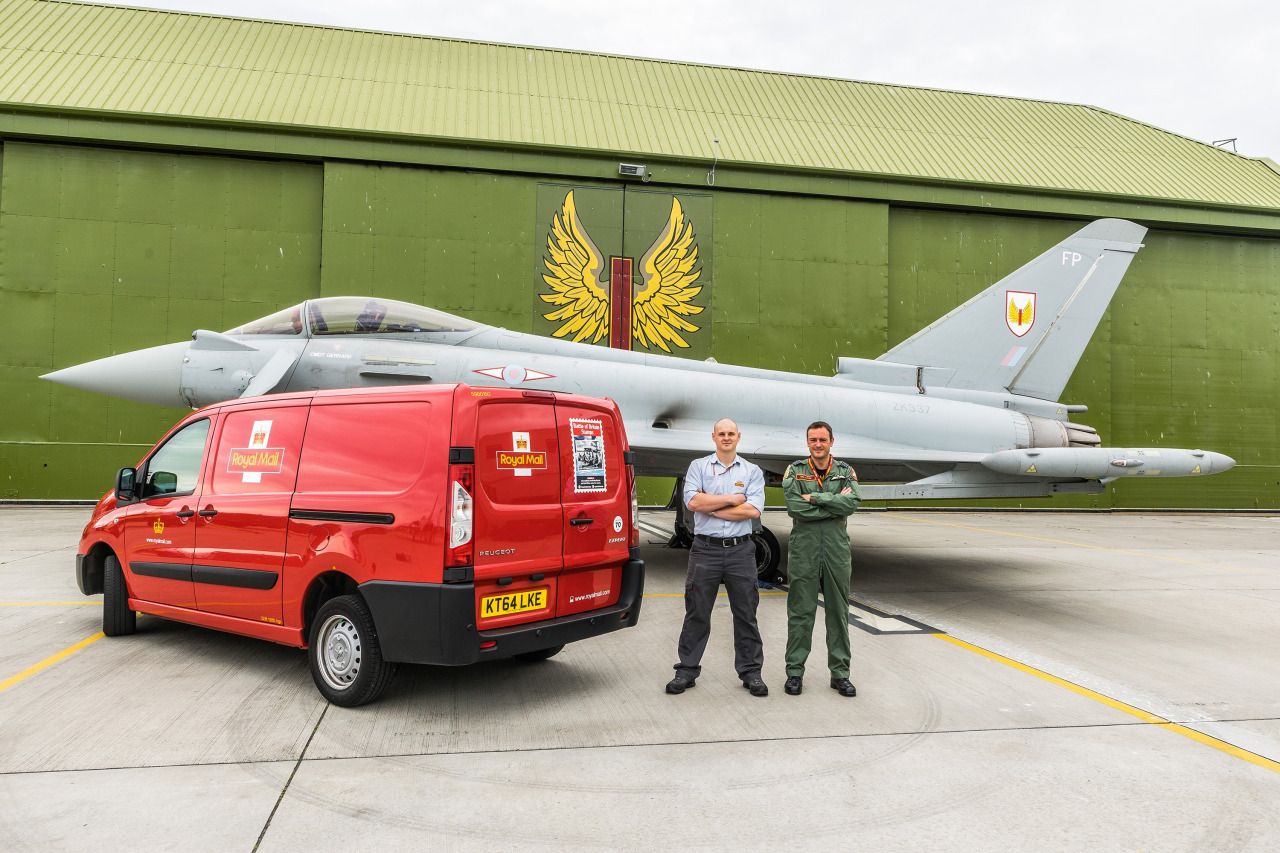
17th July
6 Squadron Typhoons based at Amari Air Base in Estonia are ready to scramble at a moment?s notice to intercept aircraft that have not filed a flight plan, or who are not communicating with air traffic controllers. The pilots and ground crew are there as a part of 121 Expeditionary Air Wing in support of NATO?s Baltic Air Policing mission to secure the airspace around Estonia, Latvia and Lithuania.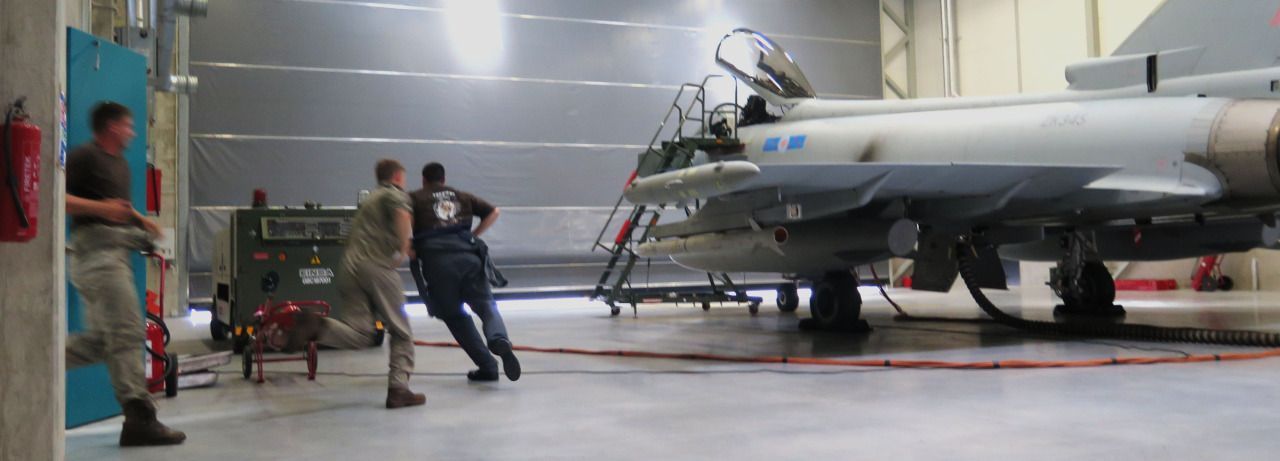
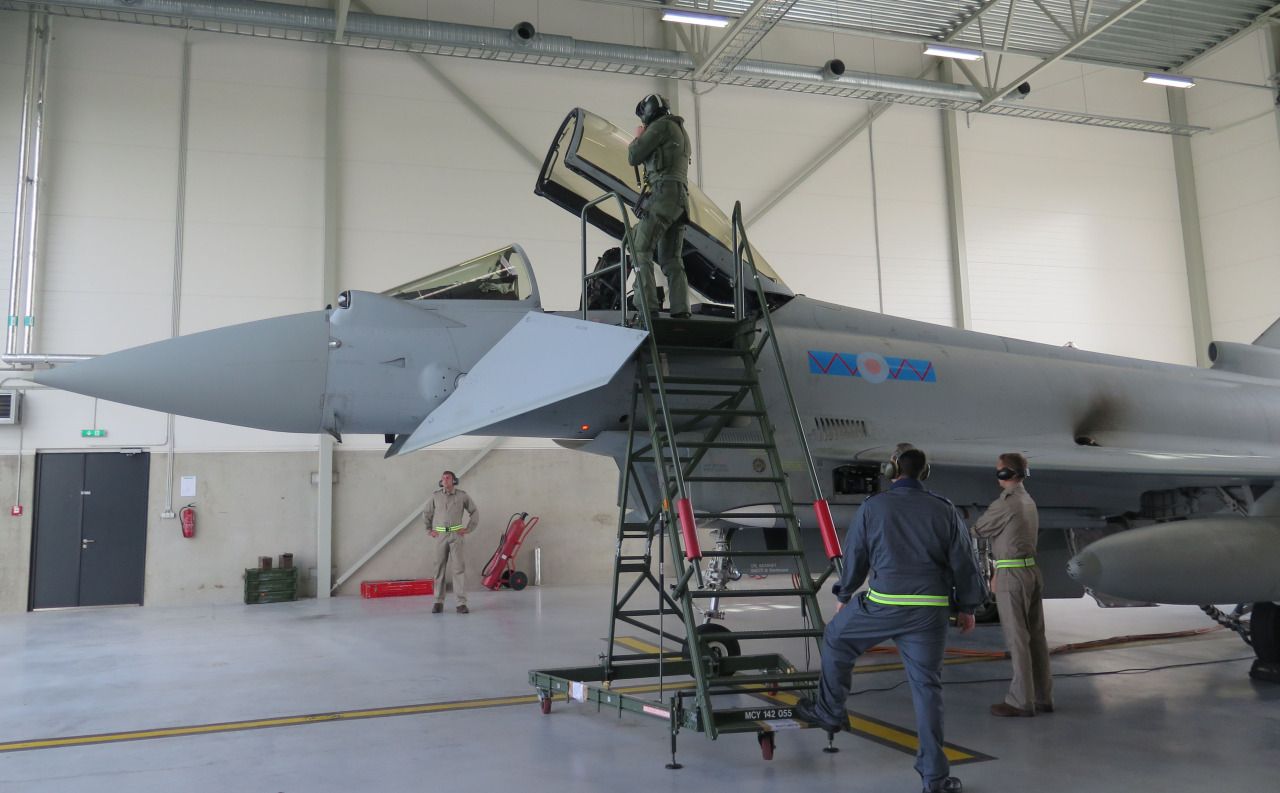
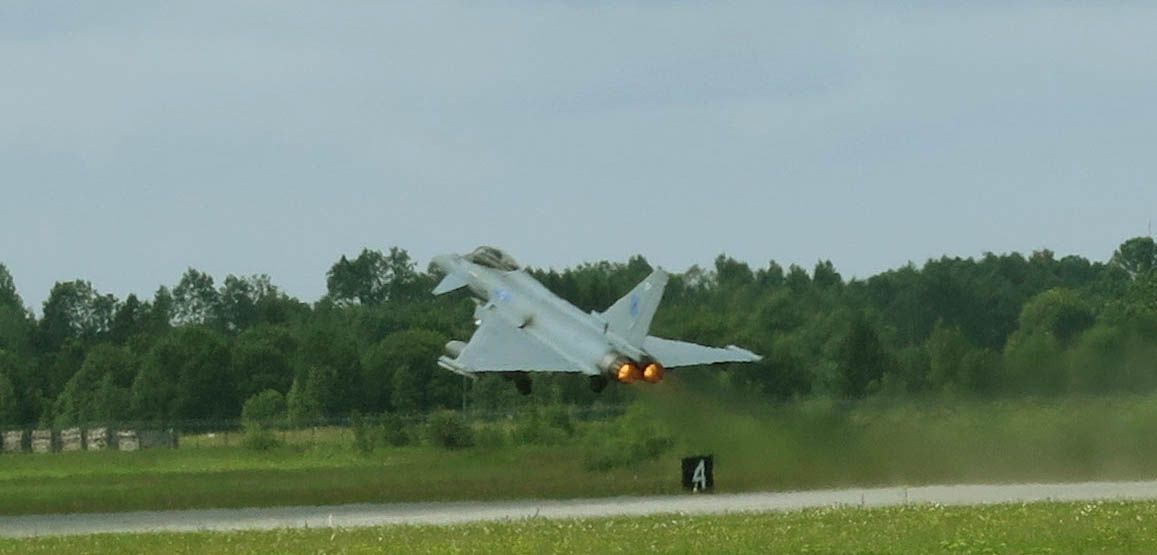
A 35th Fighter Squadron F-16 Fighting Falcon pilot prepares to taxi as Senior Airman Jeff Bryant, 35th Aircraft Maintenance Unit crew chief, conducts a pre-flight inspection during Exercise Beverly Midnight 15-4, at Kunsan Air Base, Republic of Korea, July 16, 2015. During the five-day operational readiness exercise, the Wolf Pack responded to counterattack tactics, simulated enemy attacks and generated combat airpower in a simulated chemical, biological, radiological, nuclear and high-yield explosive environment. (U.S. Air Force photo by Senior Airman Katrina Heikkinen/Released)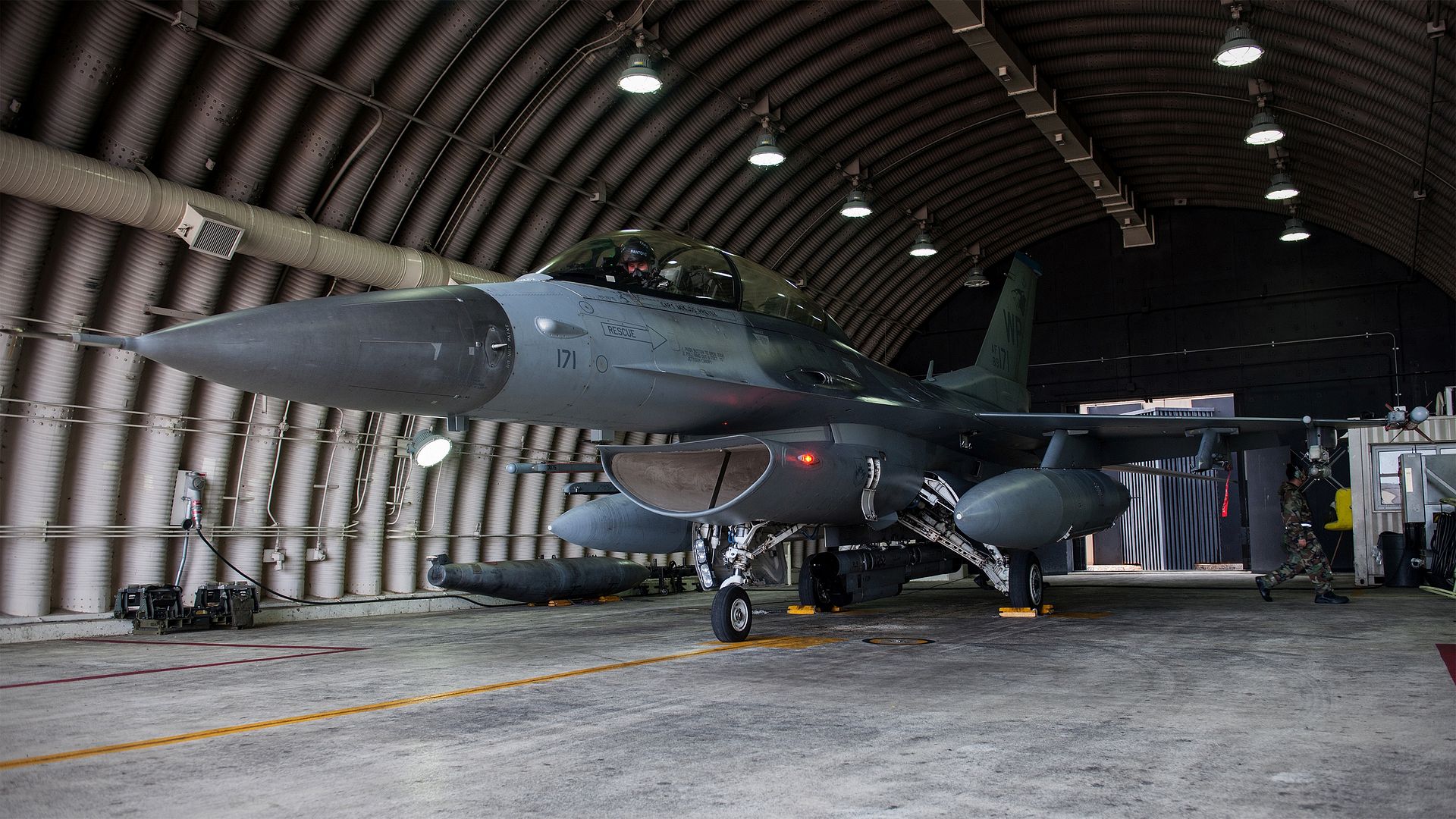
A 35th Fighter Squadron F-16 Fighting Falcon taxis on the Kunsan Air Base runway as an 80th Fighter Squadron F-16 Fighting Falcon takes off during Exercise Buddy Wing 15-4 at Kunsan Air Base, Republic of Korea, July 16, 2015. The five-day quarterly operational readiness exercise enhanced strategic capabilities at Kunsan by generating combat airpower in a simulated chemical, biological, radiological, nuclear and high-yield explosive environment. (U.S. Air Force photo by Senior Airman Katrina Heikkinen/Released)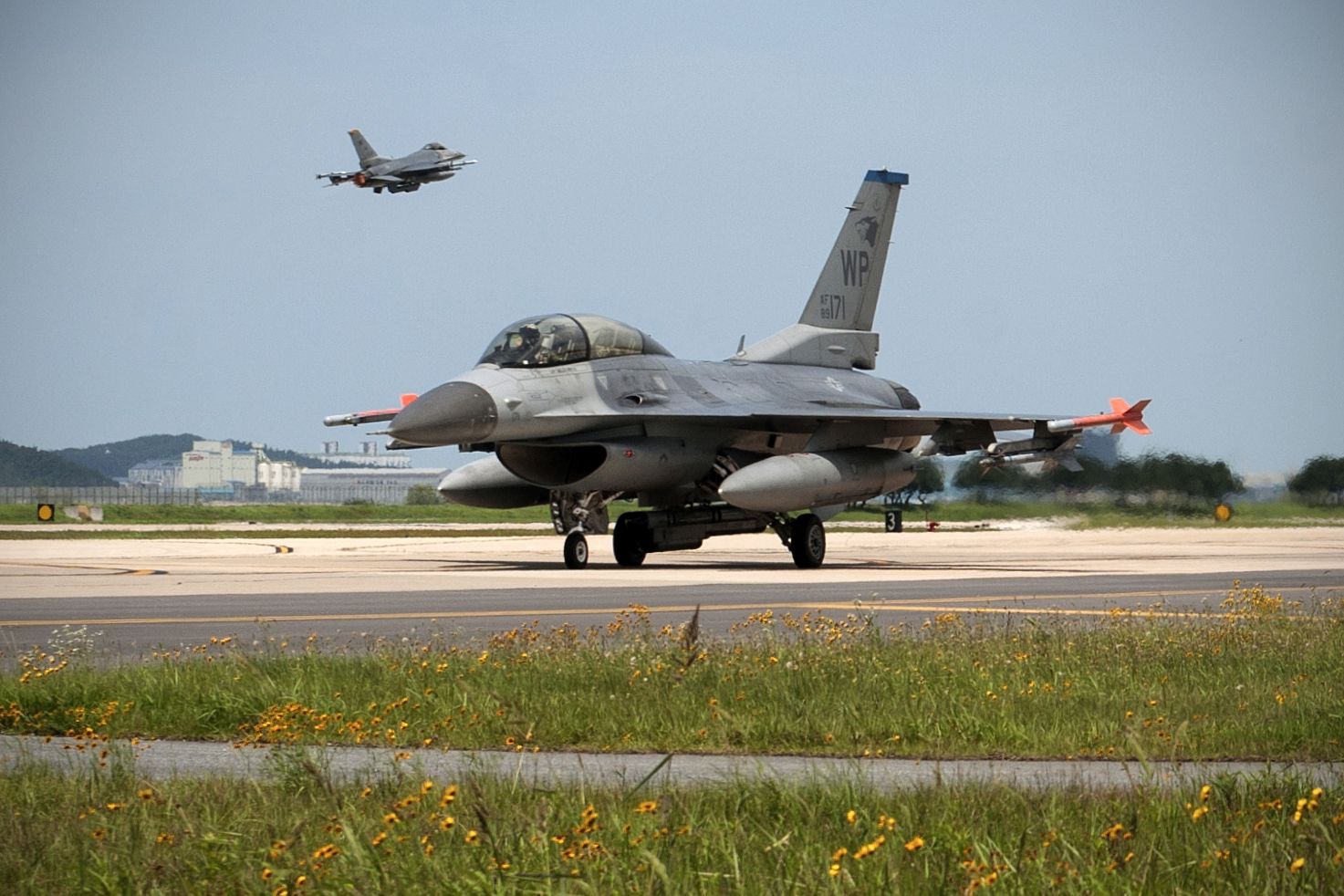
-
 Main Admin
Main Admin -
 Main AdminA U.S. Air National Guard F-15C Eagle fighter aircraft assigned to the 123rd Expeditionary Fighter Squadron flies over the flightline during the2015 Campia Turzii Air Show July 19, 2015, at Campia Turzii, Romania. The aircraft deployed to Romania in support of Operation Atlantic Resolve to bolster air power capabilities while underscoring the U.S.?s commitment to European security and stability. (U.S. Air Force photo by Senior Airman Dylan Nuckolls/Released)
Main AdminA U.S. Air National Guard F-15C Eagle fighter aircraft assigned to the 123rd Expeditionary Fighter Squadron flies over the flightline during the2015 Campia Turzii Air Show July 19, 2015, at Campia Turzii, Romania. The aircraft deployed to Romania in support of Operation Atlantic Resolve to bolster air power capabilities while underscoring the U.S.?s commitment to European security and stability. (U.S. Air Force photo by Senior Airman Dylan Nuckolls/Released)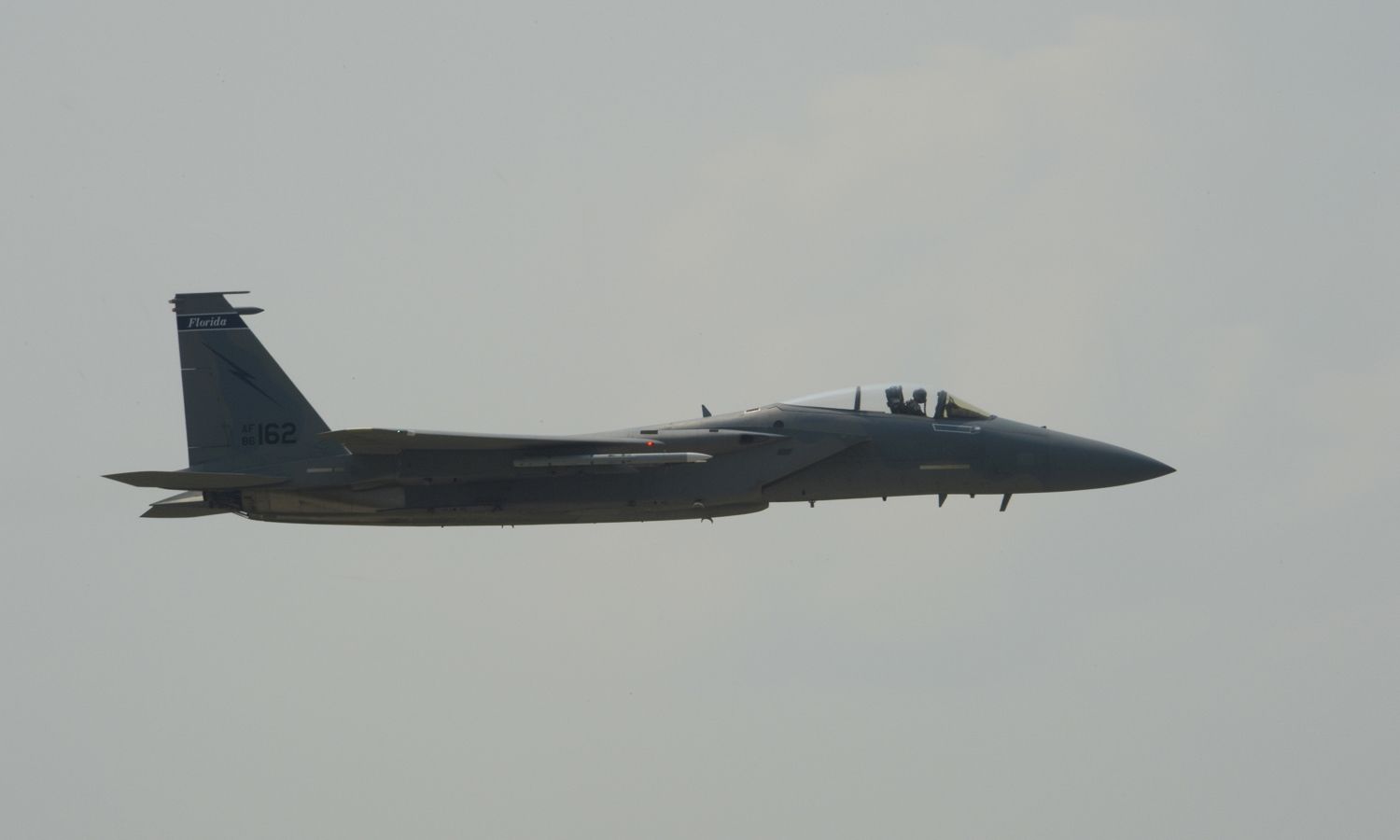
Two U.S. Air National Guard F-15C Eagle fighter aircraft assigned to the 123rd Expeditionary Fighter Squadron and two Romanian MiG-21 fighter aircraft fly over a flightlinein formation during the 2015 CampiaTurzii Air Show July 19, 2015, at CampiaTurzii, Romania. More than 200 Airmen from the 142nd Fighter Wing, Oregon Air National Guard, Portland, Oregon, trained with the Romanian air force as part of a European theater security package of F-15Cs deployed to Romania. (U.S. Air Force photo by Senior Airman Dylan Nuckolls/Released)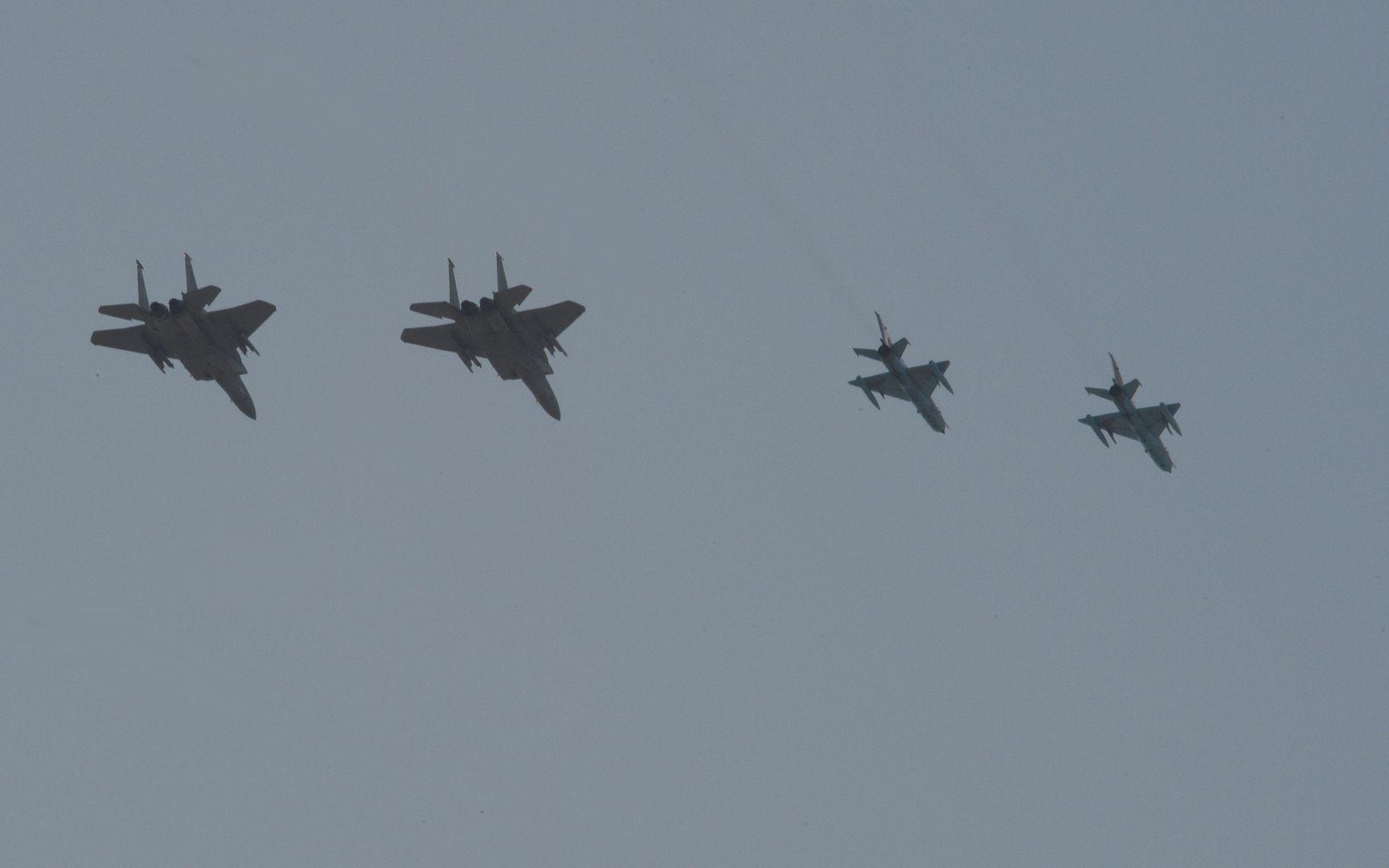
A Romanian MiG-21 fighter aircraft takes off during the 2015 Campia Turzii Air Show July 19, 2015, at Campia Turzii, Romania. The air show celebrated the Romanian air force?s birthday and had static displays of aircraft, tanks and military equipment. (U.S. Air Force photo by Senior Airman Dylan Nuckolls/Released)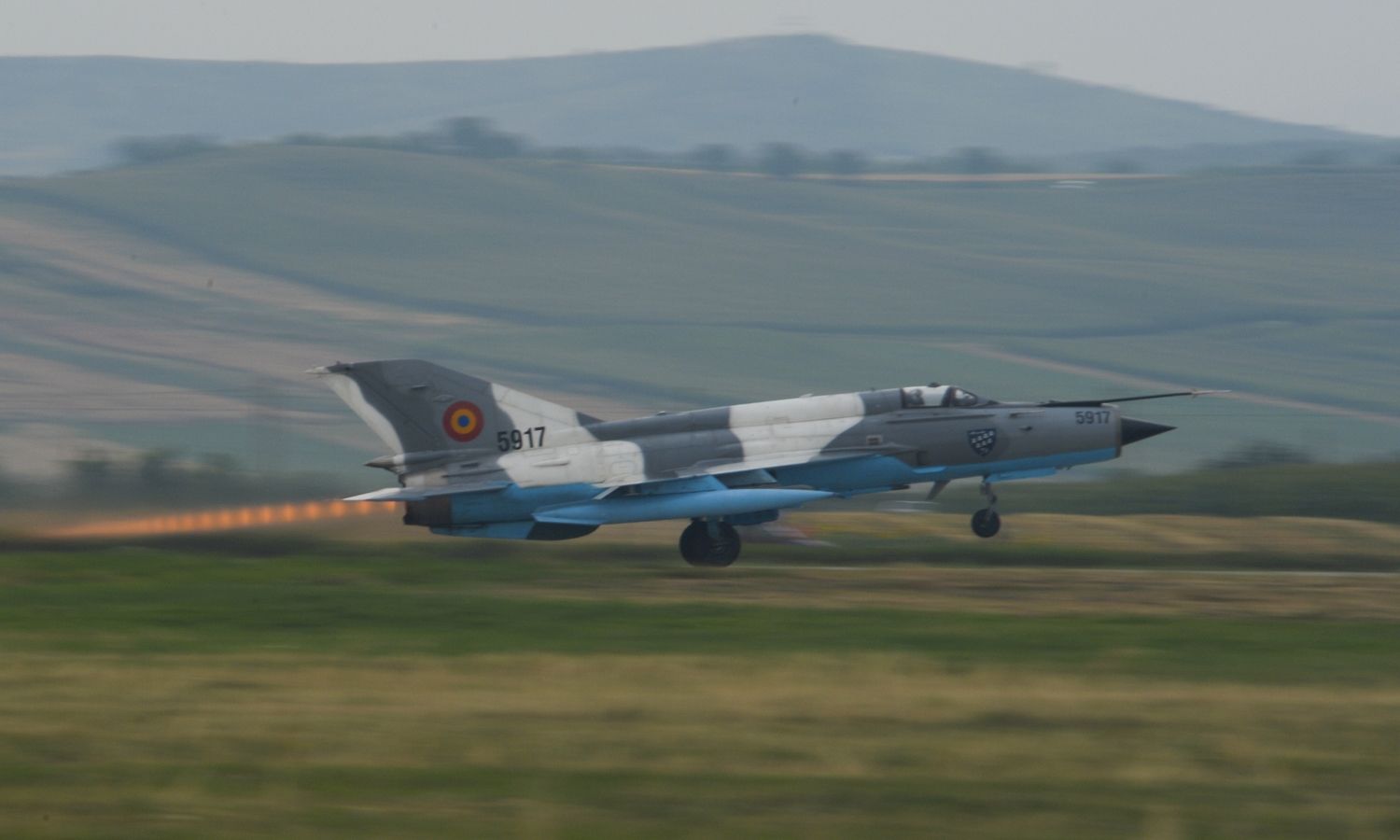
An F-35A Lightning II aircraft assigned to Nellis AFB, Nev., is on static display during the 34th Fighter Squadron?s activation ceremony held July 17 at Hill Air Force Base, Utah. The 34th will be the first combat squadron to fly the Air Force?s newest fighter aircraft, the F-35A. The squadron has an extremely rich history. After many contributions in major U.S. conflicts, the 34th was relocated to Hill AFB on Dec. 8, 1975, where they became the first fighter squadron to receive the F-16 fighter aircraft. The squadron?s first F-35A will arrive in September. (U.S. Air Force photo by Alex R. Lloyd/Released)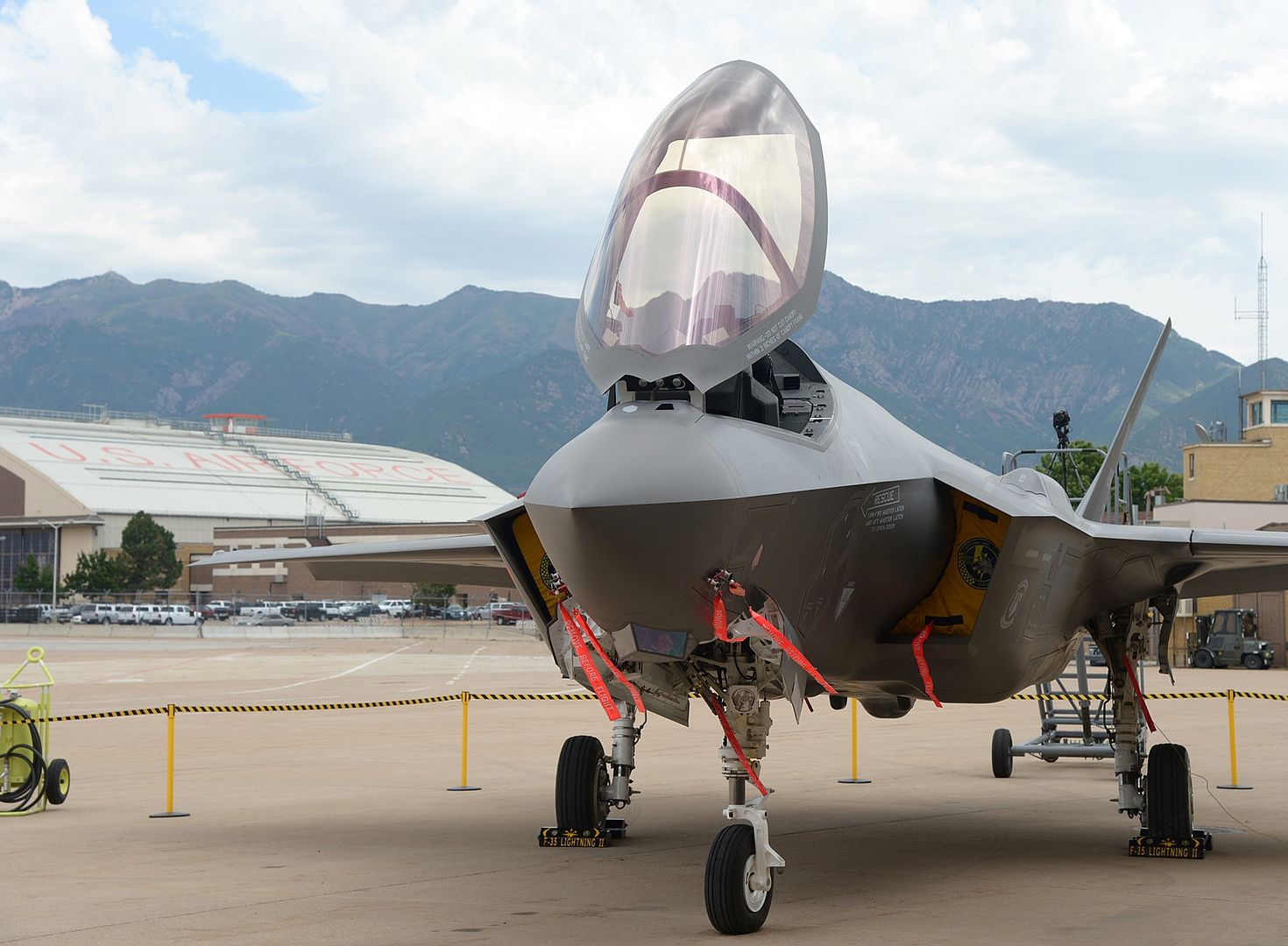
Two F-35A Lightning II aircraft are on static display during the 34th Fighter Squadron?s activation ceremony held July 17 at Hill Air Force Base, Utah. The 34th will be the first combat squadron to fly the Air Force?s newest fighter aircraft, the F-35A. The squadron has an extremely rich history. After many contributions in major U.S. conflicts, the 34th was relocated to Hill AFB on Dec. 8, 1975, where they became the first fighter squadron to receive the F-16 fighter aircraft. The squadron?s first F-35A will arrive in September. (U.S. Air Force photo by Alex R. Lloyd/Released)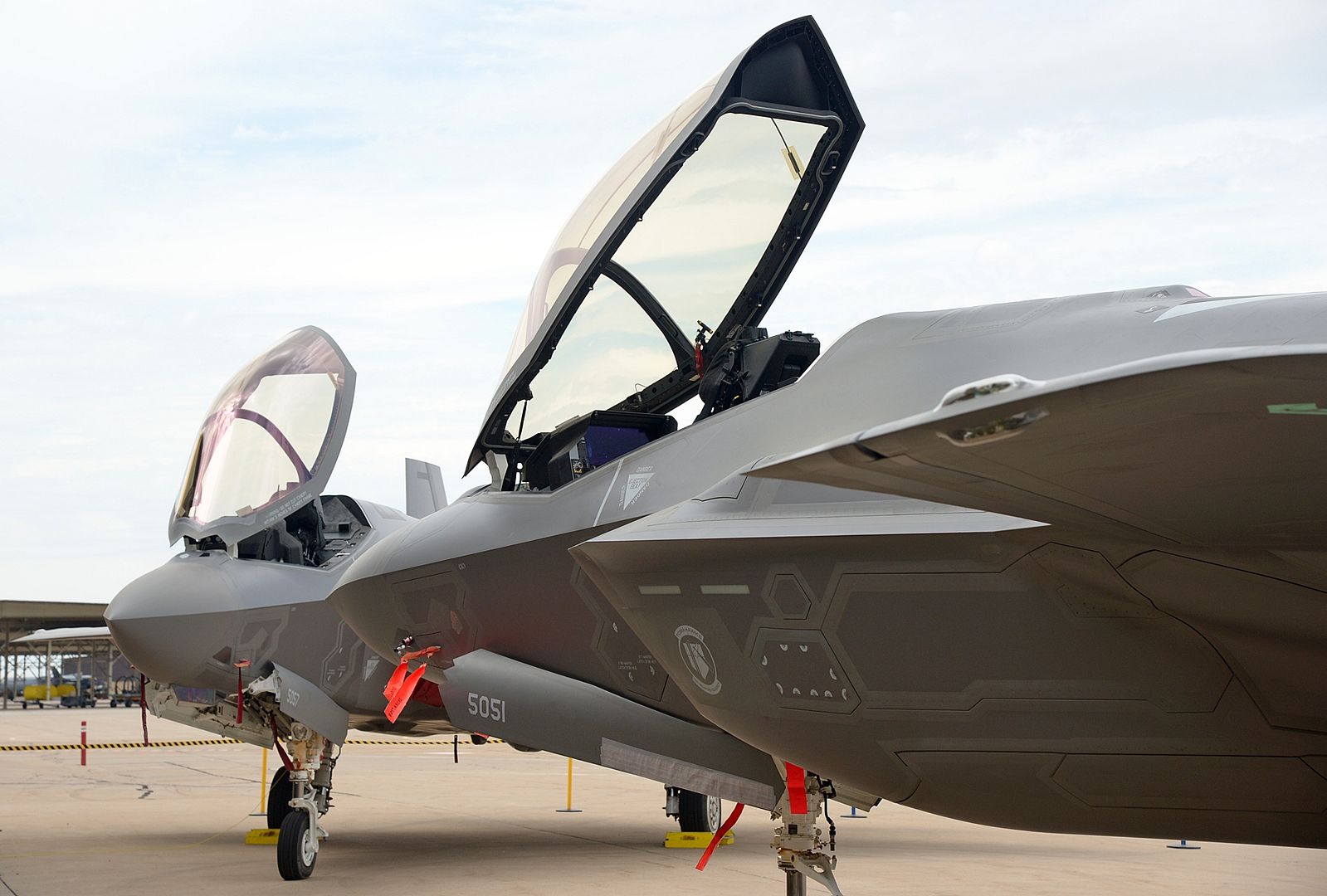
An F-35A Lightning II aircraft from Luke Air Force Base, Ariz., banks right past the control tower upon arriving at Hill Air Force Base, Utah, where it was seen on static display during 34th Fighter Squadron?s activation ceremony held July 17 at Hill AFB. The 34th will be the first combat squadron to fly the Air Force?s newest fighter aircraft, the F-35A. The squadron has an extremely rich history. After many contributions in major U.S. conflicts, the 34th was relocated to Hill AFB on Dec. 8, 1975, where they became the first fighter squadron to receive the F-16 fighter aircraft. The squadron?s first F-35A will arrive in September. (U.S. Air Force photo by Alex R. Lloyd/Released)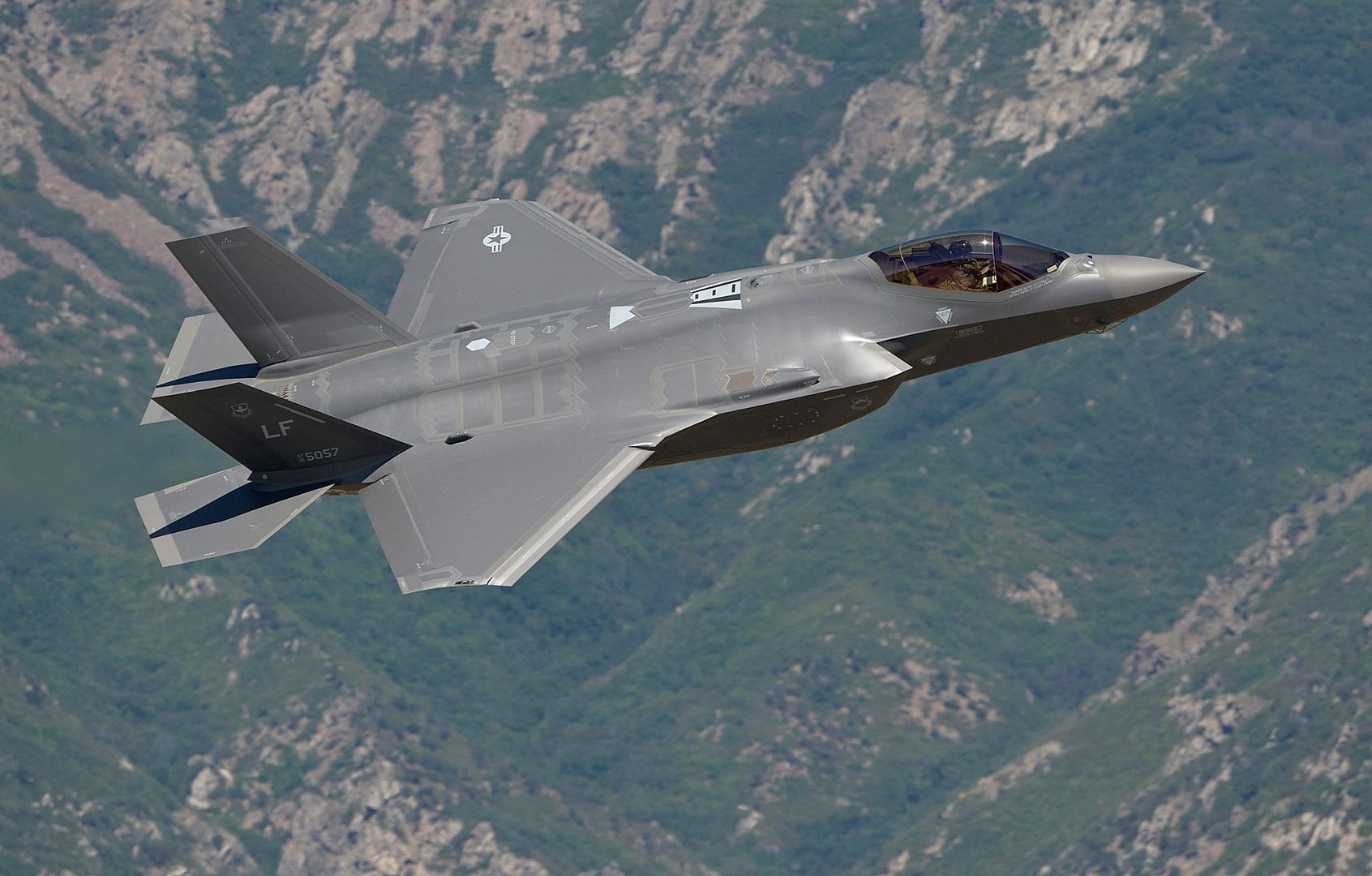
-
9 years agoTue Jul 21 2015, 05:26pm
 Main AdminJuly 19th
Main AdminJuly 19th
Two icons of British aviation, the Red Arrows and Vulcan bomber, have performed a joint flypast for the last time at the Royal International Air Tattoo.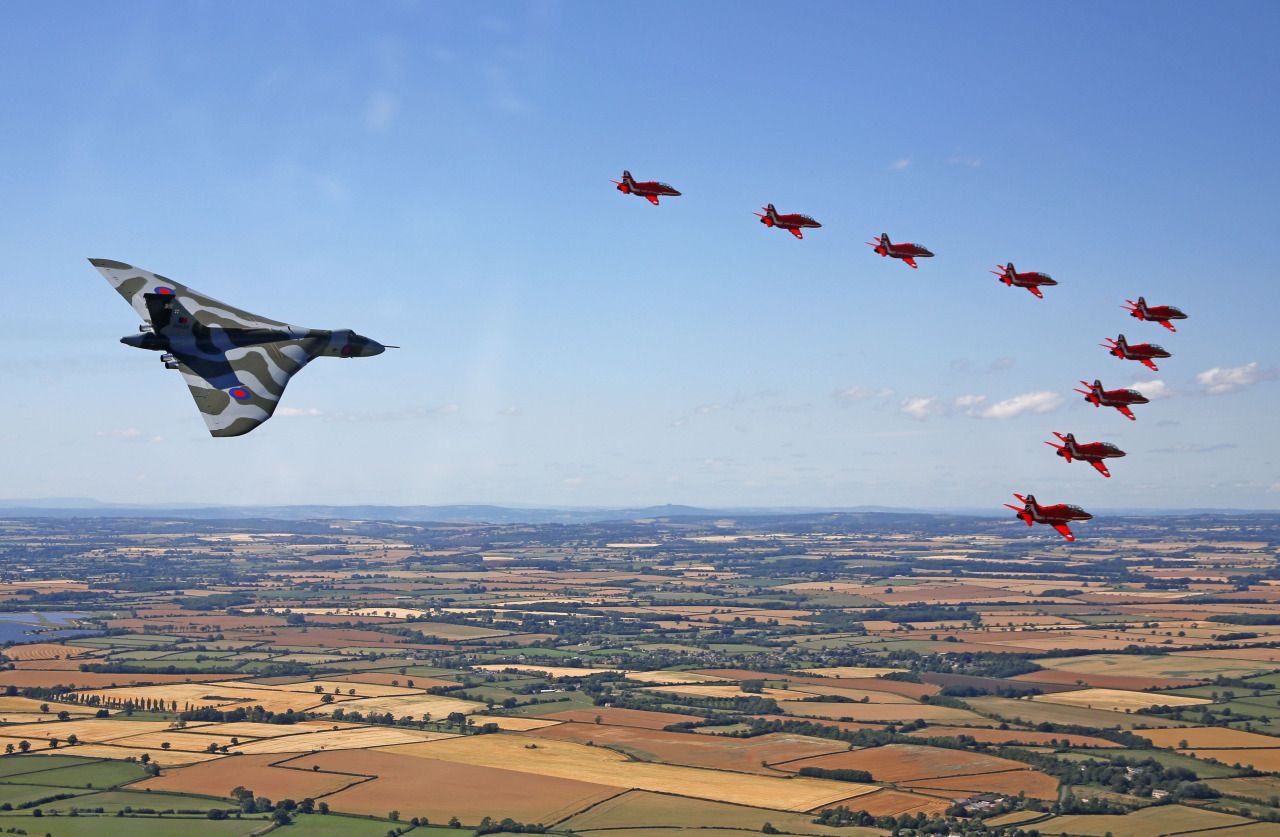
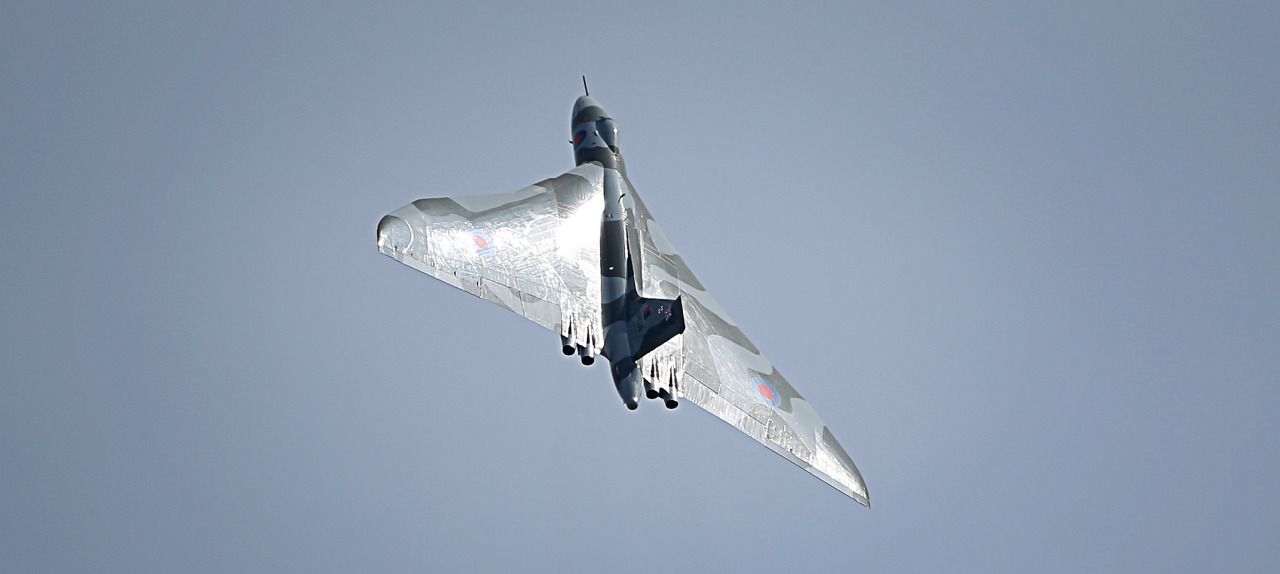


An F-15E Strike Eagle assigned to the 389th Fighter Squadron, Mountain Home Air Force Base, Idaho, flies during a Red Flag 15-3 sortie at Nellis Air Force Base, Nev., July 17, 2015. The F-15E Strike Eagle is a dual-role fighter designed to perform air-to-air and air-to-ground missions. (U.S. Air Force photo by Staff Sgt. Siuta B. Ika)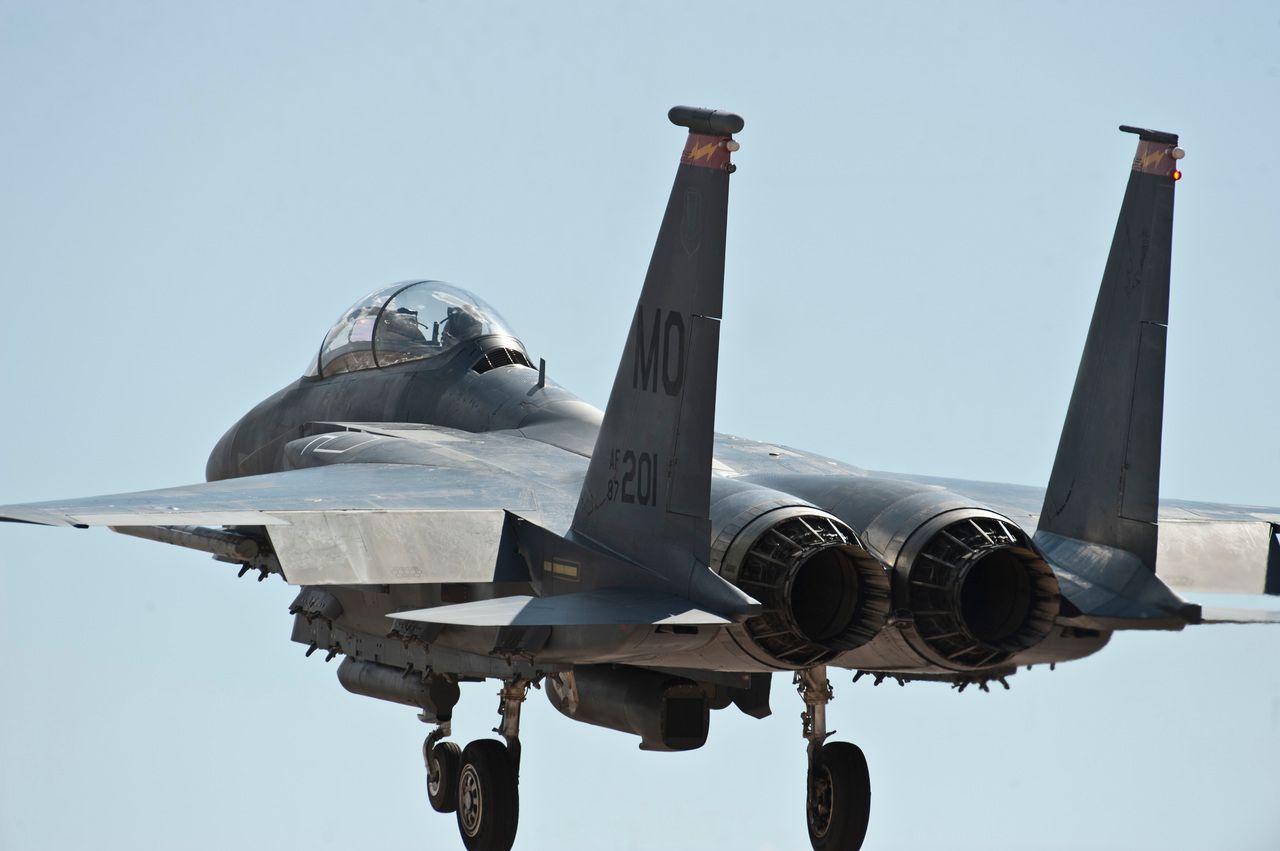
An F-16 Fighting Falcon assigned to the 480th Fighter Squadron, Spangdahlem Air Base, Germany, flies during a Red Flag 15-3 sortie at Nellis Air Force Base, Nev., July 17, 2015. Red Flag is a realistic combat training exercise involving the air forces of the U.S. and its allies. (U.S. Air Force photo by Staff Sgt. Siuta B. Ika)
An F-16 Fighting Falcon assigned to the 55th Fighter Squadron, Shaw Air Force Base, S.C., on approach after returning from a Red Flag 15-3 sortie at Nellis Air Force Base, Nev., July 17, 2015. Red Flag provides combat training in a degraded and operationally limited environment making the training missions as realistic as possible. (U.S. Air Force photo by Airman 1st Class Jake Carter)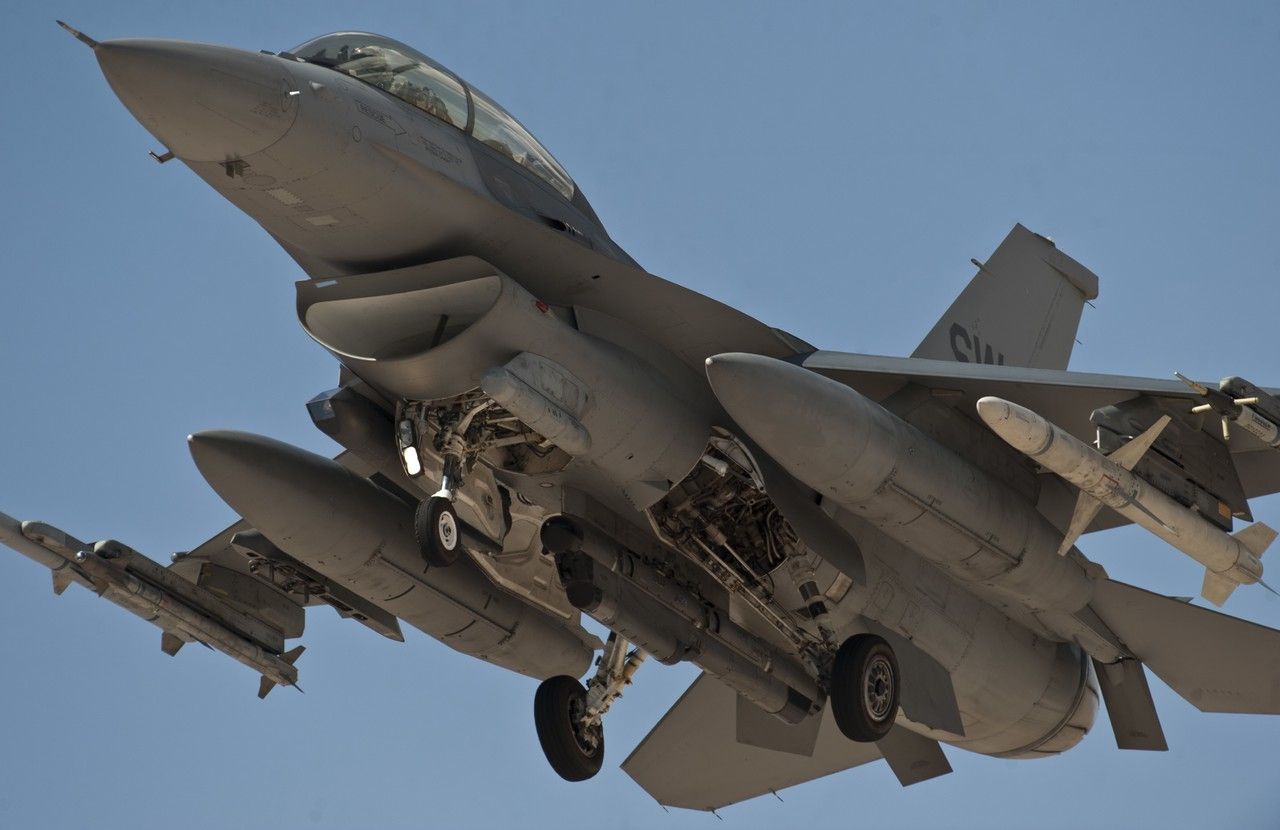
SEATTLE, July 21, 2015 -- Boeing and EVA Air have finalized an order for five 777 Freighters. The order, valued at more than $1.5 billion at list prices, will represent the first 777 Freighters to join EVA Air's fleet, and the first to be delivered to a Taiwanese airline.
Boeing first announced EVA Air's intent to order the five 777 Freighters at the 2015 Paris Air Show last month.
"Airfreight is an important link in global trade," EVA Air Chairman K.W. Chang said. "We are investing in the most advanced aircraft and committing ourselves to continuing to ensure efficient, reliable service. Quality service and flight safety are our top priorities at EVA and we apply the same high standards to cargo services. We are determined to make EVA the world's best airline for both passenger and cargo services."
The Taiwanese airline plans to use the new freighters to bolster its fleet on trans-Pacific and Asian routes in an effort to meet growing demand in the air cargo market.
"As EVA Air continues to modernize their world-class freighter fleet, we are honored that they have selected the 777 Freighter to maintain their position as one of the largest cargo airlines," said Boeing Commercial Airplanes President and CEO Ray Conner. "This order further validates the strength of the long-term partnership between EVA Air and Boeing over the last several decades."
EVA Air currently operates more than 35 Boeing airplanes, including 20 777-300ERs. With 13 additional 777-300ERs on order ? both direct purchased and leased ? EVA will become one of the largest 777 operators in the world. The carrier plans to grow its operational twin-aisle fleet to more than 60 airplanes by the end of 2025.
"We are pleased to be the first airline in Taiwan to introduce Boeing 777 freighters," EVA President Austin Cheng said in his remarks. "EVA participated in development of the Boeing 777-300ER and became a launch customer. We now fly 21 Boeing 777-300ERs and have 13 more on order. We have made the right choice as our experience with this aircraft's advanced technology and excellent performance indicates what we can expect from the Boeing 777 freighters. These freighters will be the backbone of our air cargo service for the next decade."
The 777 Freighter is the world's largest and longest range twin-engine freighter, capable of flying 4,900 nautical miles (9,070 kilometers) with a full payload at general cargo market densities. The airplane's range capability translates into significant savings for cargo operators: fewer stops and associated landing fees, less congestion at transfer hubs, lower cargo handling costs and shorter cargo delivery times.
20 July 2015 Press Release
Airbus has achieved EASA certification of its innovative *Runway Overrun Prevention System (ROPS) technology on A330 Family aircraft. This on-board cockpit technology, which Airbus has pioneered over several years, is now certified and available on all Airbus Families. ROPS is an alerting system which reduces exposure to runway overrun risk, and if necessary, provides active protection. Korean Air will become the first A330 operator to implement ROPS on its A330s in service in the coming months.
This EASA certification of ROPS on the A330 marks a key milestone in making ROPS available for line-fit and retrofit to all Airbus models. ROPS was first approved by the European Aviation Safety Agency (EASA) on the A380 in October 2009 and to date is currently in service or ordered on most of the A380 fleet. ROPS is also part of the A350 XWB?s basic configuration, and in August 2013 was also certified for the A320 Family.
?Already in service on the A380, A350 and A320 Families, ROPS is the result of years of continuing research by Airbus,? said Didier Lux, Airbus? SVP Head of Customer Services. He adds: ?This EASA certification for ROPS on the A330 Family is an example where innovative technology and services meet for the benefit of operators and aviation safety, and is thus an important step to offering the enhanced operational benefits across all our aircraft."
Runway excursion ? meaning either an aircraft veering off the side of the runway, or overrunning at the very end ? remains the primary cause of civil airliner hull losses, particularly as other formerly prevalent categories of aircraft accidents have now largely been eliminated. Furthermore, various industry bodies including the EASA, NTSB, Eurocontrol and FAA recognize this and are fully behind the introduction of effective measures by commercial aviation stakeholders to eliminate the risk of runway excursions.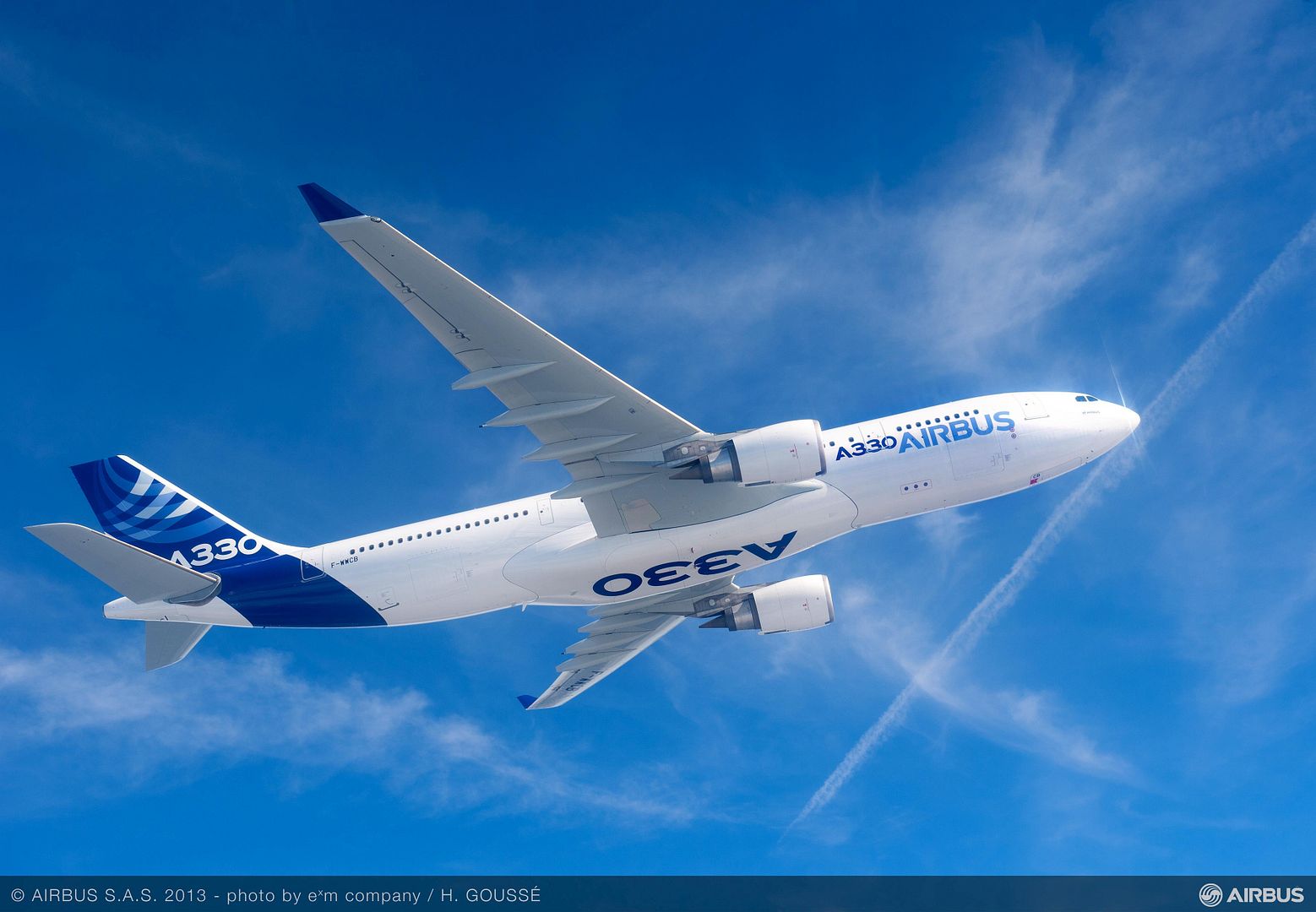
America's Newest Nuclear Bomb B61-12 Flight Test
Oshkosh
First ICON A5 delivered.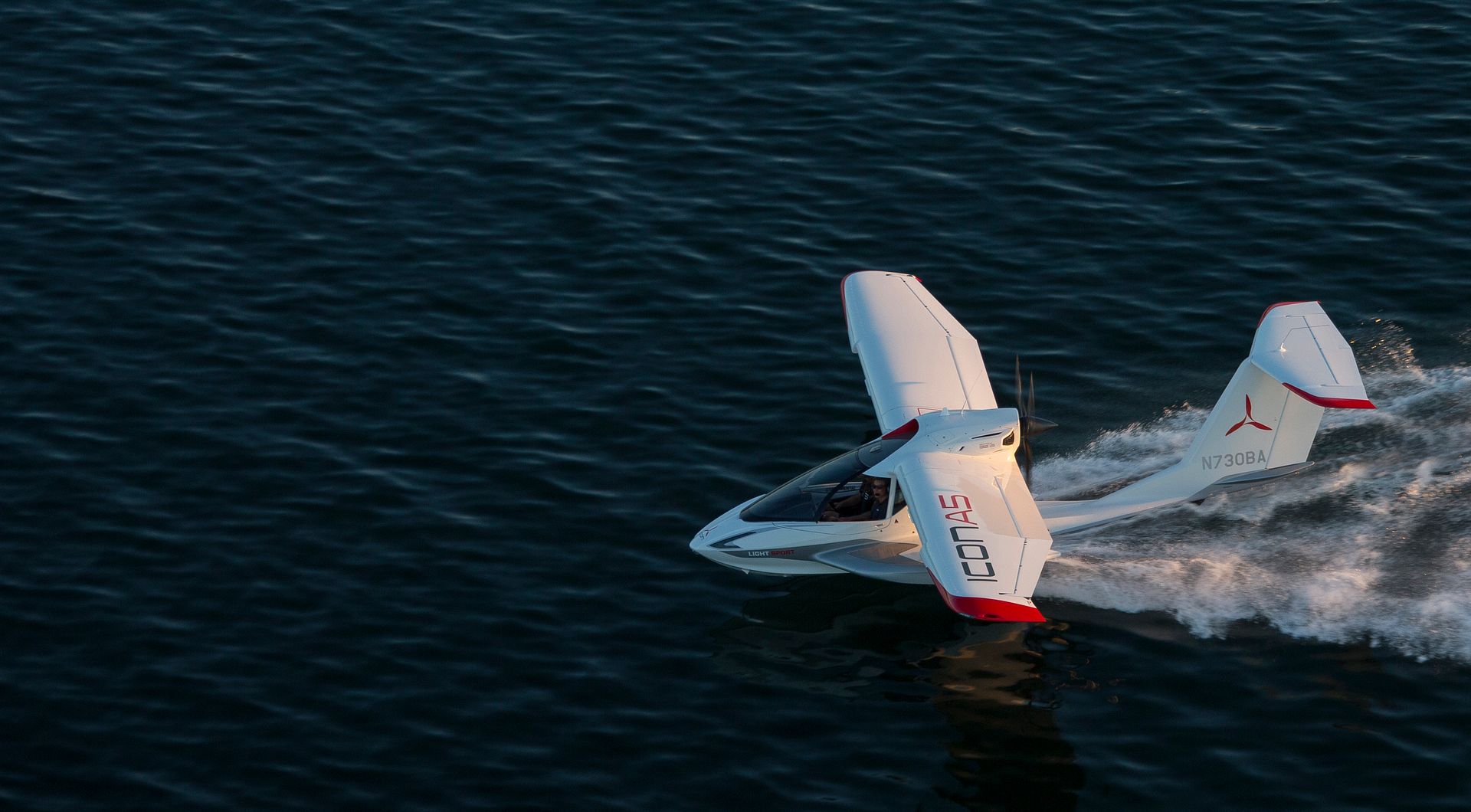
LINK - what a neat aircraft http://iconaircraft.com/news/the-icon-experience/ -
9 years agoWed Jul 22 2015, 05:59pm
 Main Admin22 July 2015
Main Admin22 July 2015
Rumours of a black puma being spotted in Kabul this week proved to be true, as the RAF?s 230 Squadron returned to operational duty?this time in Afghanistan.
Flying the Puma HC2 helicopter, the squadron from RAF Benson in Oxfordshire arrived in Kabul in late June, bringing with them a character not seen on operational duty for over 70 years.
Sporting a unique colour scheme, ?Black Peter? as it?s affectionately known was specially painted in 2014 to commemorate the 95th anniversary of the helicopter squadron, as well as the 70th anniversary of when the original Black Peter last took to the skies.
In 1944, operating Sunderland flying boats in Ceylon, the Commanding Officer, Wing Commander Dundas Bednall had his aircraft JM 673 ?P? (for Peter), painted matt black to reduce the chance of being spotted during night patrols. Sadly, on the 28th of November ?44, Black Peter as it had already become known was lost in the Bay of Bengal during a cyclone. Despite extensive searches, the aircraft and all its crew have never been found.
70 years on, the squadron is in Afghanistan supporting UK and coalition forces on the Resolute Support Mission; a non-combat NATO-led operation, training, advising and assisting Afghan Security Forces to develop a stable, secure and prosperous country of their own. The Puma squadron of aircrew, engineers and support staff makes up almost a quarter of the 400 plus UK military personnel in the country following the end of combat operations in late 2014.
State of the art avionics on the Puma 2 helicopter provide an impressive array of defensive aids and safety measures. An additional fuel tank coupled with more powerful engines than its predecessor also means that the Puma 2 can swiftly transport a greater number of troops and equipment around Kabul in the air, rather than on the busy streets of the rapidly expanding and bustling city.
As Officer Commanding of the detachment, Squadron Leader Chris Greenwood said, ?leading 230 Sqn on ops, with Black Peter with us for the first time since 1944, is an honour I will never forget. The Puma is ideal for operating in a city environment, particularly at high altitude and in such high temperatures. It can be very challenging for the aircraft and aircrew but the enhancements allow us to deliver vitally important aviation support to the NATO mission.?
The RAF squadron will return to the UK in September when it will be replaced in Afghanistan by another team from RAF Benson.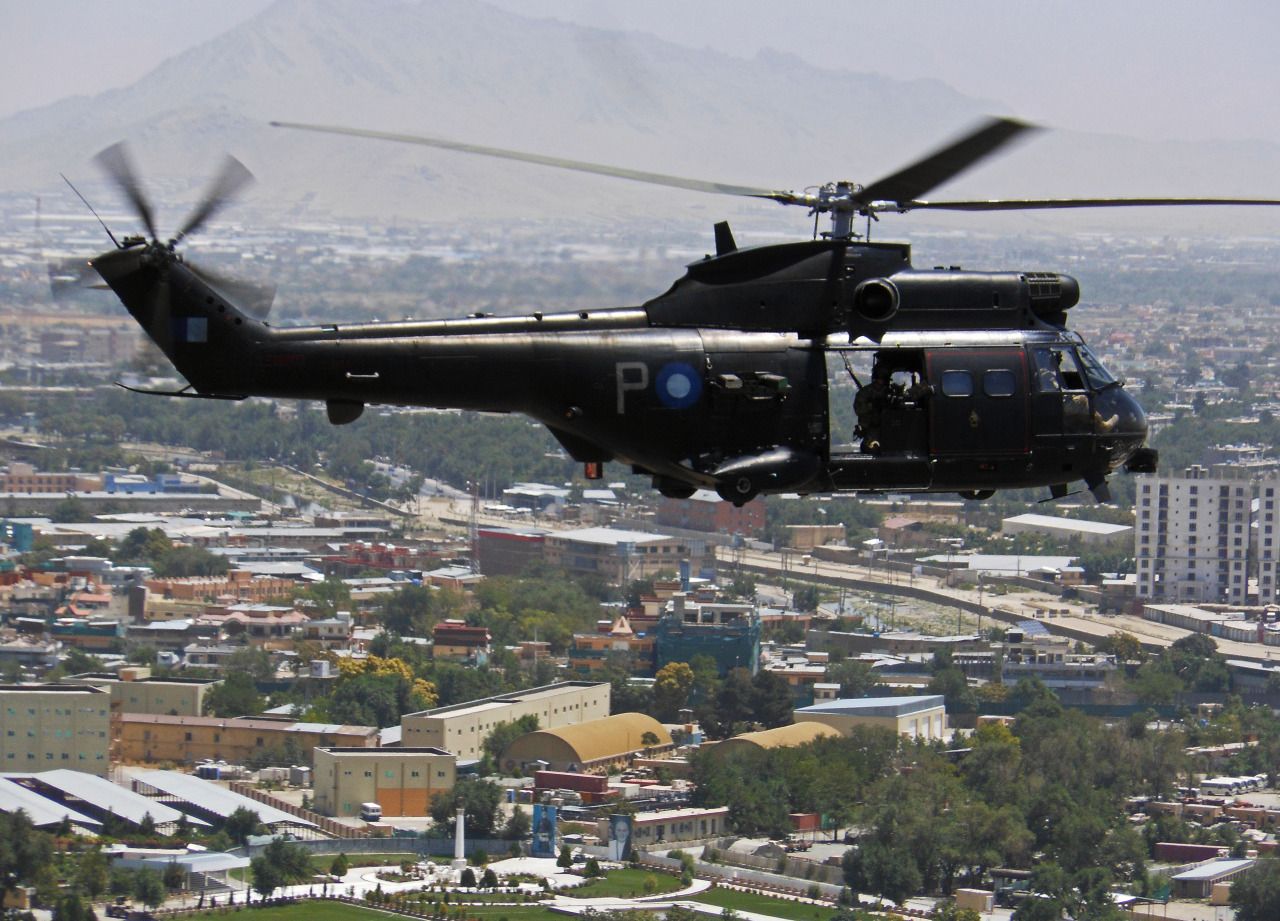
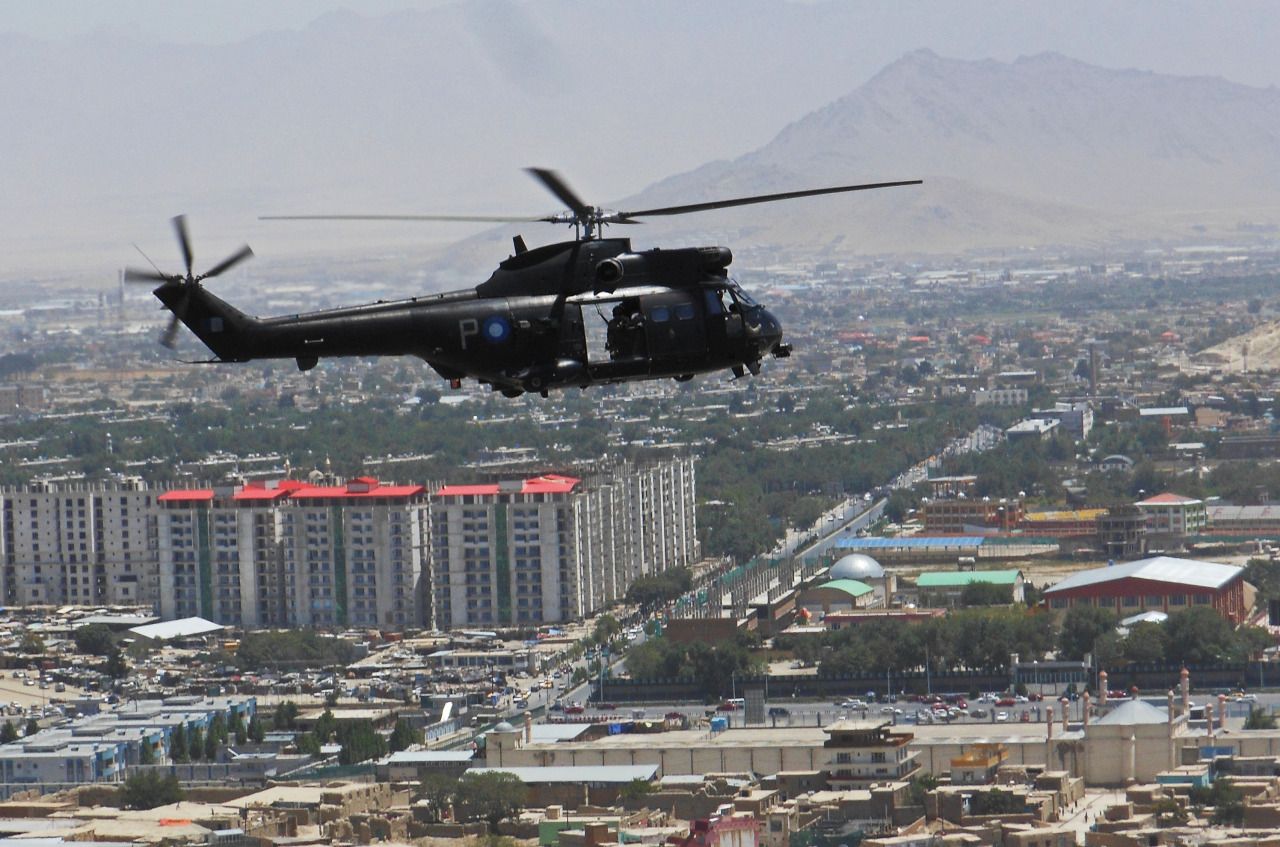
An F-22 Raptor assigned to the 95th Fighter Squadron, Tyndall Air Force Base, Fla., prepares to land on the runway after returning from a Red Flag 15-3 sortie at Nellis Air Force Base, Nev., July 17, 2015. The F-22, a critical component of the Global Strike Task Force, is designed to project air dominance, rapidly and at great distances, and defeat threats attempting to deny access to our nation's Air Force, Army, Navy and Marine Corps. (U.S. Air Force photo by Staff Sgt. Siuta B. Ika)
An EA-18G Growler assigned to Electronic Attack Squadron 138, Naval Air Station Whidbey Island, Wash., flies during a Red Flag 15-3 sortie at Nellis Air Force Base, Nev., July 17, 2015. All four branches of the U.S. military and air forces from allied nations participate in Red Flag exercises held three to four times each year. (U.S. Air Force photo by Staff Sgt. Siuta B. Ika)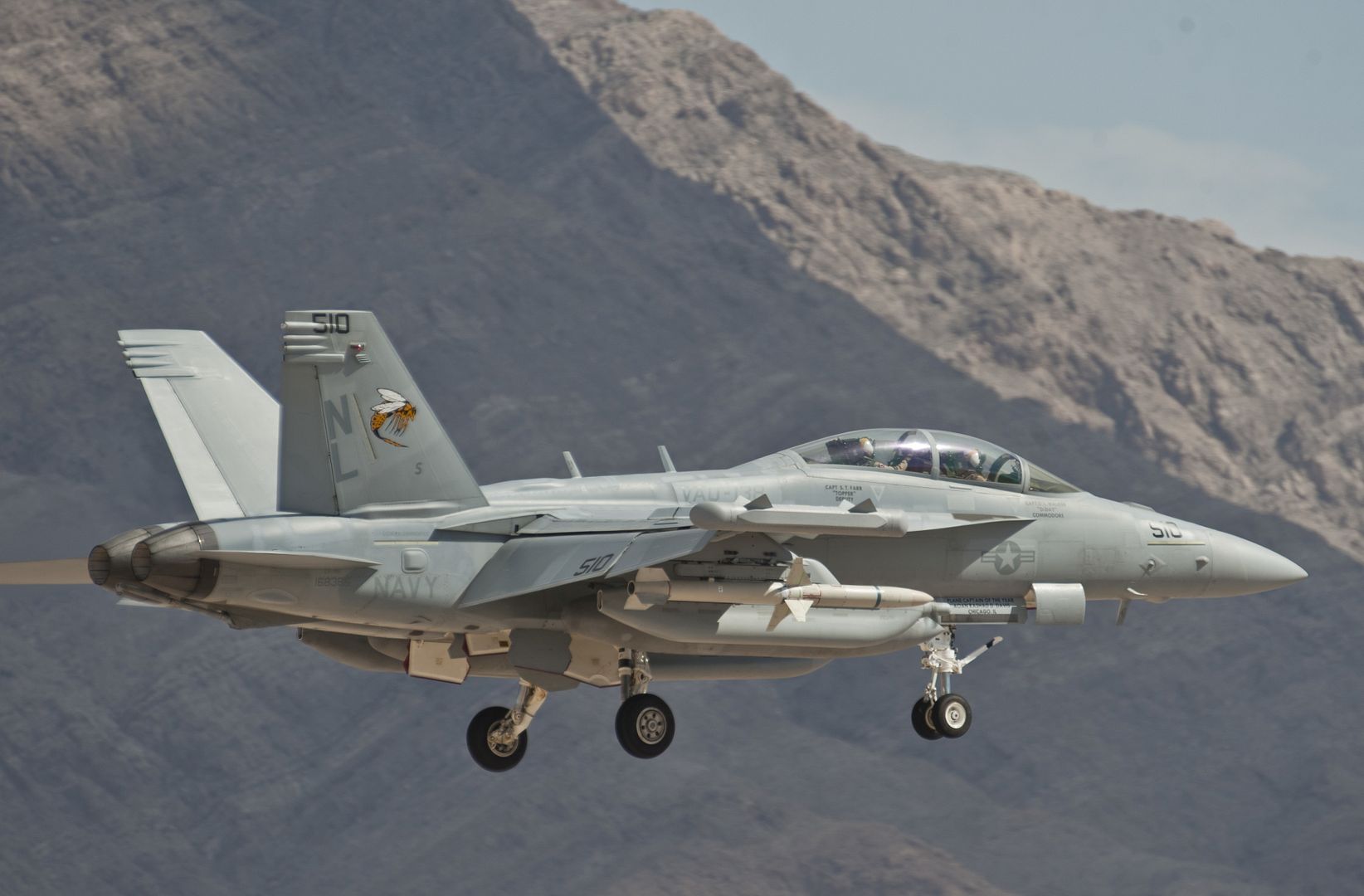
A U.S. Air National Guard F-15C Eagle fighter aircraft pilot assigned to the 123rd Expeditionary Fighter Squadron takes off from the runway July 21, 2015, at Campia Turzii, Romania. The U.S. Air Force?s forward presence in Europe allows cooperation among NATO allies and partners to develop and improve ready air forces capable of maintaining regional security. (U.S. Air Force photo by Senior Airman Dylan Nuckolls/Released)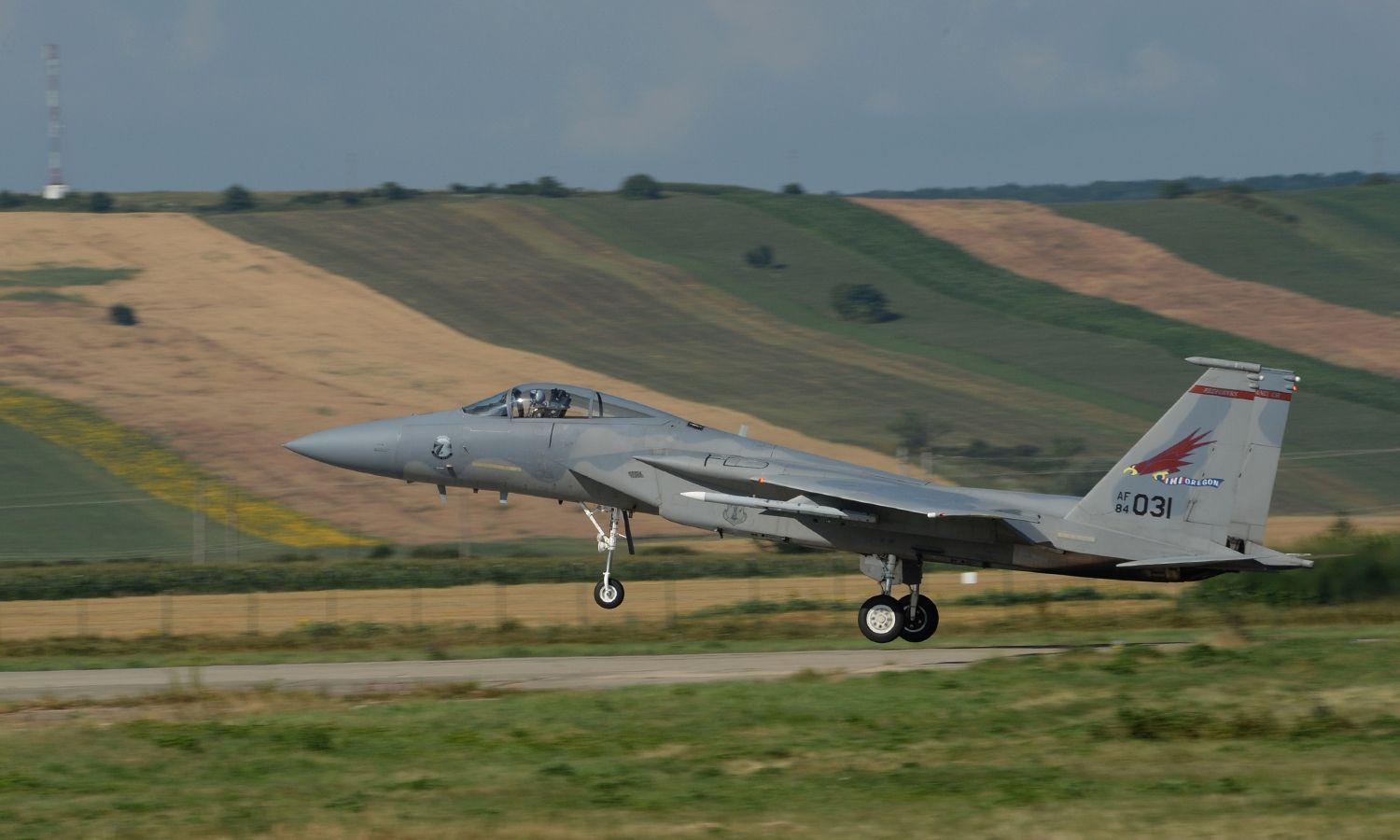
A U.S. Air National Guard F-15C Eagle fighter aircraft pilot assigned to the 123rd Expeditionary Fighter Squadron lands during a theater security package deployment July 21, 2015, at Campia Turzii, Romania. U.S. Air Force fighter squadrons have previously deployed as part of similar theater security packages to the Pacific theater since 2004. (U.S. Air Force photo by Senior Airman Dylan Nuckolls/Released)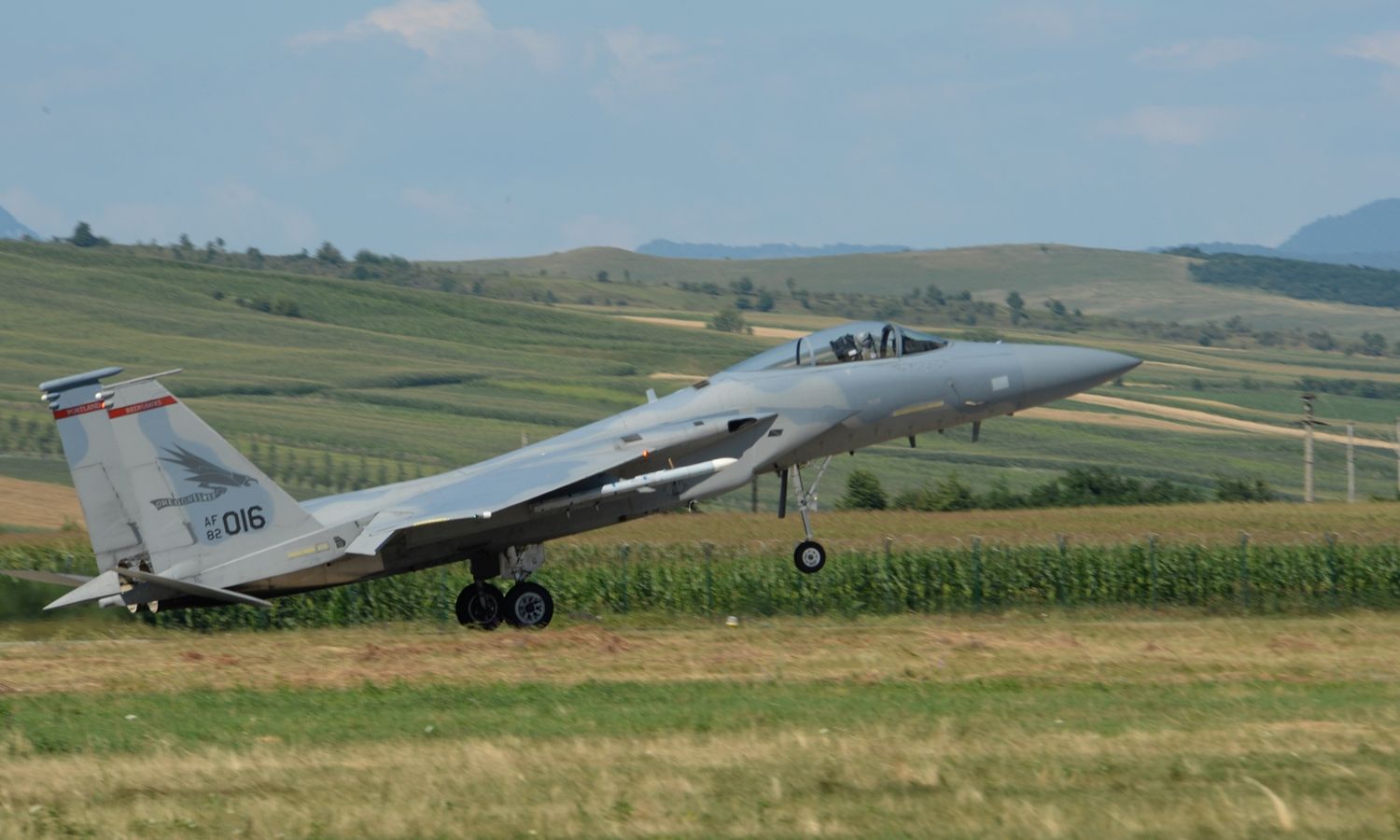
A U.S. Air National Guard F-15C Eagle fighter aircraft assigned to the 123rd Expeditionary Fighter Squadron flies over the flightline during a theater security package deployment July 21, 2015, at Campia Turzii, Romania. The 12 F-15C Eagle fighter aircraft are currently in NATO control. The transfer of authority of the F-15C Eagles to NATO allows the 123rd EFS to train with partner allies in a routine manner. (U.S. Air Force photo by Senior Airman Dylan Nuckolls/Released)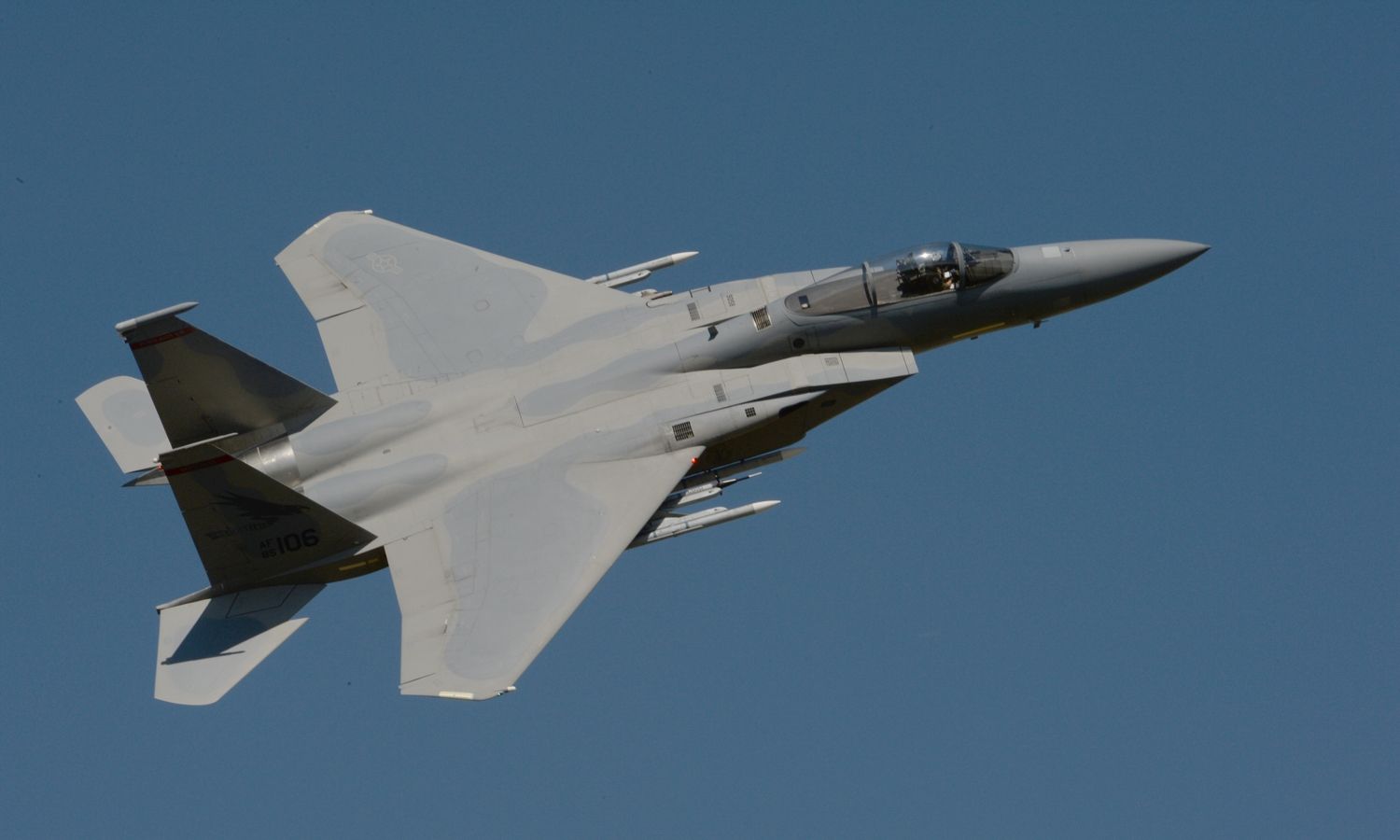
A U.S. Air National Guard F-15C Eagle fighter aircraft assigned to the 123rd Expeditionary Fighter Squadron flies over the flightline during a theater security package deployment July 21, 2015, at Campia Turzii, Romania. More than 200 Airmen from the 142nd Fighter Wing, Oregon Air National Guard, Portland, Oregon, are training with the Romanian air force as part of a European theater security package of F-15C Eagles deployed to Romania. (U.S. Air Force photo by Senior Airman Dylan Nuckolls/Released)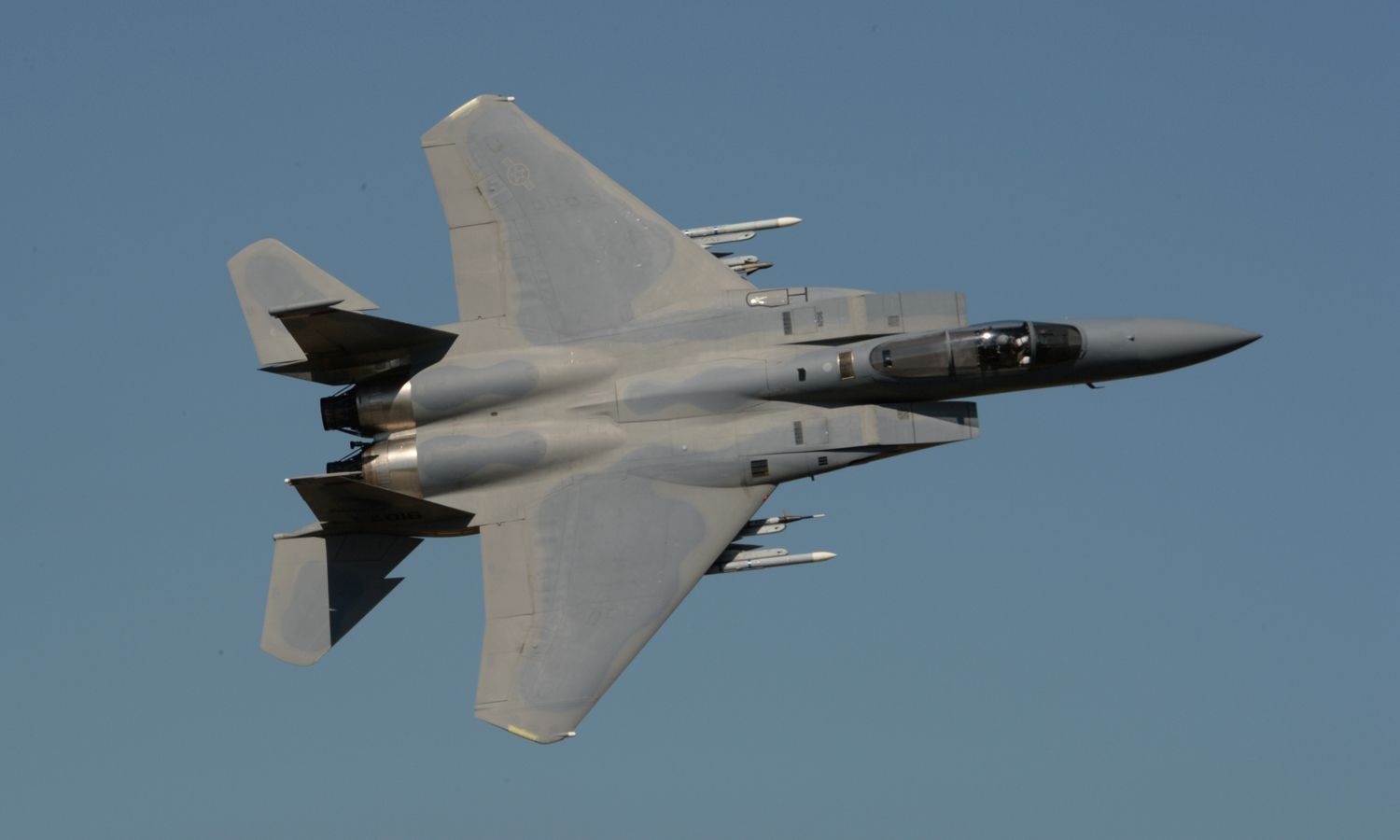
-
 Main AdminINDIAN OCEAN (July 22, 2015) ? An AV-8B Harrier, assigned to Marine Attack Squadron (VMA) 311, hovers onto the flight deck of the forward-deployed amphibious assault ship USS Bonhomme Richard (LHD 6). Bonhomme Richard is the lead ship of the Bonhomme Richard Expeditionary Strike Group and is on patrol in the U.S. 7th Fleet area of operations. (U.S. Navy photo by Mass Communication Specialist 3rd Class Taylor A. Elberg/Released)
Main AdminINDIAN OCEAN (July 22, 2015) ? An AV-8B Harrier, assigned to Marine Attack Squadron (VMA) 311, hovers onto the flight deck of the forward-deployed amphibious assault ship USS Bonhomme Richard (LHD 6). Bonhomme Richard is the lead ship of the Bonhomme Richard Expeditionary Strike Group and is on patrol in the U.S. 7th Fleet area of operations. (U.S. Navy photo by Mass Communication Specialist 3rd Class Taylor A. Elberg/Released)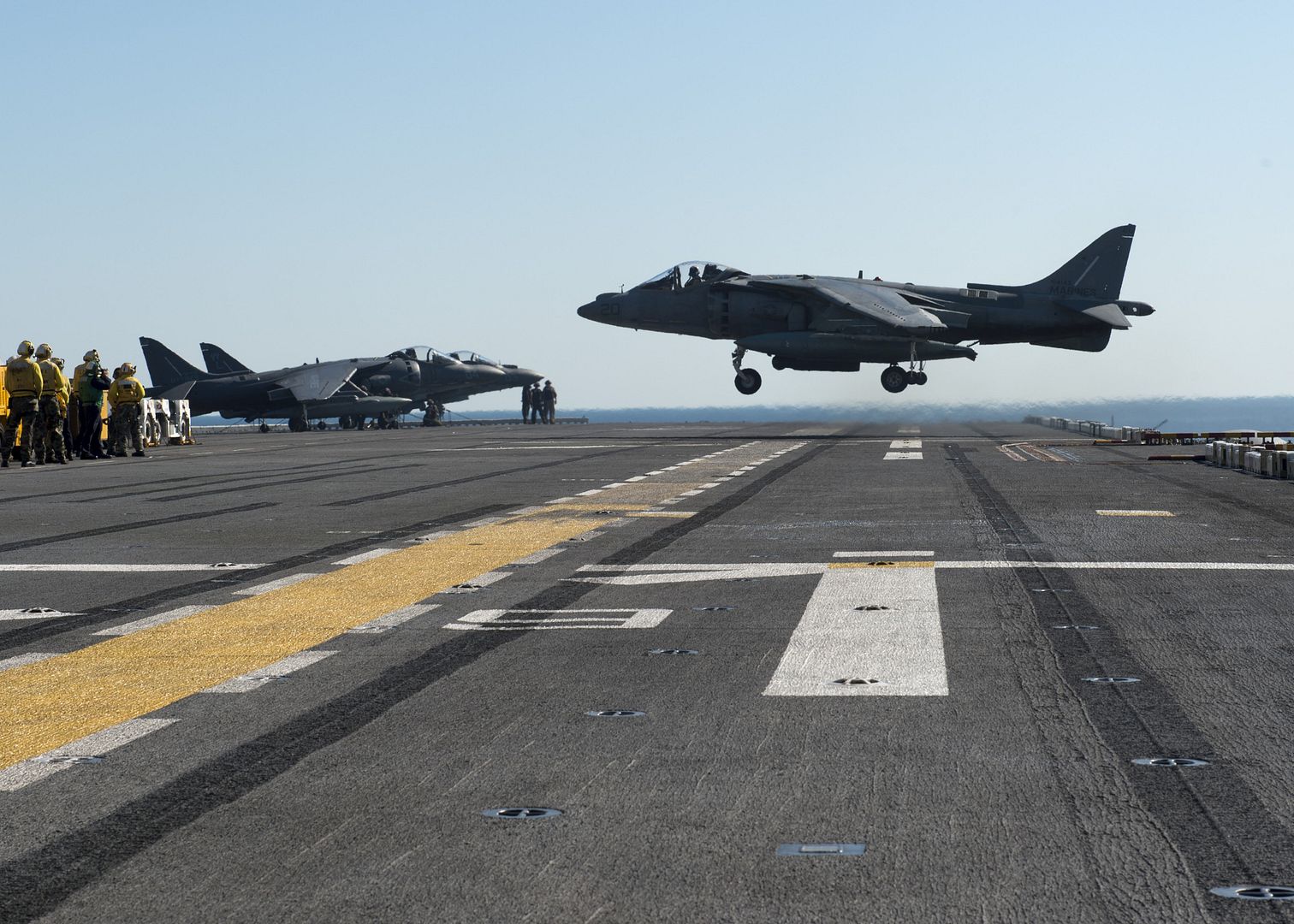
7/22/2015 - EDWARDS AIR FORCE BASE, Calif. -- The F-35 Joint Strike Fighter Integrated Test Force is in the process of testing the F-35A's newest munitions asset - the GAU-22/A. The gun is a four-barrel Gatling gun that fires 25 millimeter rounds.
Unlike the Marine Corps and Navy variants, the GAU-22/A is integrated internally to the F-35A. In the other variants, the gun is mounted to the outside as a pod. A similar weapon, GAU-12, has been used on the AV-8B Harrier Jump Jet.
The first phase of testing started June 9, when the first shots were fired from tail number AF-2 on the ground at the Edwards Gun Harmonizing Range. The test team hopes to finish ground testing sometime during August and start the airborne phase late September. An operational gun capability will be added with a future block of software, which is in the beginning stages of testing at Edwards.
The tests are done using a target practice round, PGU-23/U, which fires from the gun, but does not explode on impact.
The tricky part about this test phase is that the gun will never operationally fire on the ground. To conduct the test, they have to use software to bypass interlocks and "fool the aircraft to make it think it's in the air."
"As an Air Force pilot, it's going to be one more thing that I can select to either strafe air-to-ground targets or shoot as an air-to-air weapon," said Maj. Andrew Rollins, 461st Flight Test Squadron, assistant director of operations.
Rollins is the test pilot on the project. While deployed, Rollins "used a gun often." He said it's particularly useful in an air-to-ground role when enemy targets are in a close proximity to friendlies and dropping a bomb is not prudent.
"The GAU-22/A uses a 25mm shell, which is significantly more powerful than what I've been used to in legacy aircraft, the F-16 the F-15E, F-15C - all those aircraft use a 20mm shell," said Rollins.
Integrating a weapon into the aircraft is not in itself unique. But what does make this project special is that it's being integrated into a stealth platform. In legacy aircraft, the gun fires through a hole in the outer molding. In this case, to keep the jet hidden from radar signatures, the gun will be kept behind closed doors until the trigger is engaged.
The ground tests with AF-2 are designed to answer questions like; does the gun door open correctly? Does the gun spin up and down correctly? Does the air flow through the vent and is it adequate to clear the flammable gasses?
Prior to testing the integration of the GAU-22/A into the F-35A, the gun itself was tested as a standalone. It was also flown during test points without firing to ensure that the flight envelope would not overstress the gun mounts. Preparing for the ground gun fire tests in the jet took roughly six months.
AF-2, a highly modified flight sciences aircraft, underwent four months of instrumentation modifications and had a line production gun installed for this project.
Tiffany Krogstad, Lockheed Martin AF-2 flight test engineer, said that the AF-2 is normally a "scientist aircraft" executing loads and buffet testing.
"[AF-2] is the only aircraft in the world that can get us this data," said Rollins. "It's been highly instrumented in order to get us the information we need to proceed to the next test point and ultimately to get the gun to its full envelope."
As the test conductor, Krogstad and her team are monitoring the gun's performance and ensuring all the systems work as designed. She is especially concerned with making sure the jet can withstand the loads of a firing gun and the gun operates as expected. Since AF-2 is a flight sciences aircraft, it does not have all the missionized systems of full-line production aircraft. The gun will be further tested with a line production jet sometime next year for full integration.
"When we hand [the gun] off to the next aircraft to test full integration with the full avionics and mission systems capabilities, we'll rest easy knowing that we did what we could to make sure that their test won't have those issues," said Krogstad.
Rollins on the other hand is looking at it from a test pilot's perspective, evaluating the gun's effects on the aircraft's handling qualities.
"By the time we get airborne, we're hoping that our extensive preparation during planning, ground tests and airborne tests will eliminate every variable except for those associated with flight since flying will be the most demanding phase of this testing," said Rollins. "While we'll be targeting very specific objectives, the pilot will also be observing more qualitative effects such as muzzle flash, human factors, and flying qualities."
During the airborne tests, they will watch for the potential effects of having the gun mounted internally, like vibrations, acoustics and airflow.
To evaluate the gun's performance, the test team is made up of personnel from the Air Force, Lockheed Martin, Pratt & Whitney and Northrop Grumman. They are performing duties as engineers, pilots, maintainers, Edwards weapons loading crews, and gun subject matter experts from Fort Worth, Texas.
"Like any of the testing Edwards AFB does, we are managing all of the risk involved with this test," said Rollins. "When we sign it off and go hand it to the warfighter, they can go out and pull the trigger throughout the entire gun envelope and know that the aircraft is going to function properly. It's not going to flameout, it's not going to overheat, it's not going to over G, and it's going to hit the target."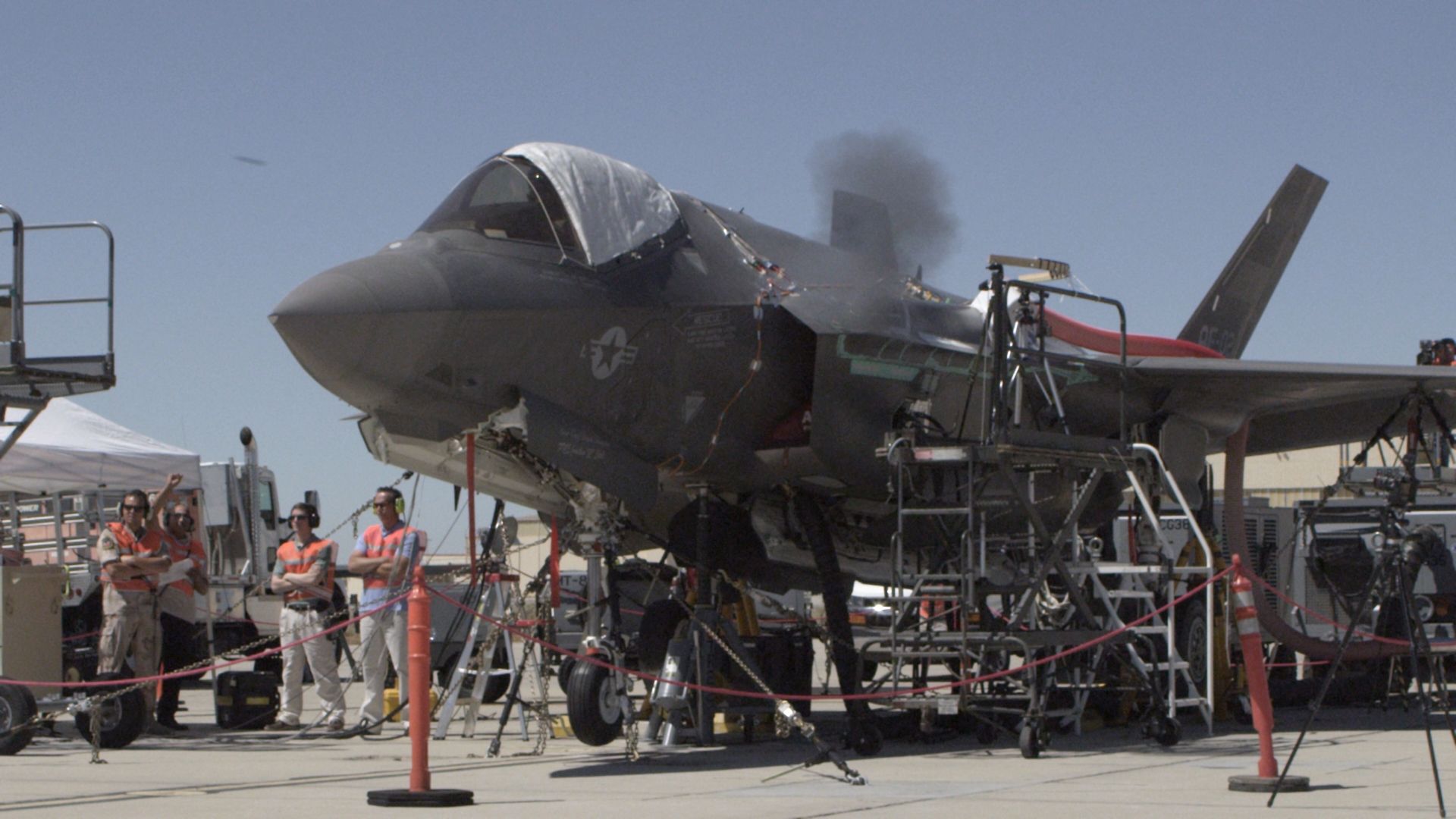

Post a reply
- Go to Next topic
- Go to Welcome
- Go to Introduce Yourself
- Go to General Discussion
- Go to Screenshots, Images and Videos
- Go to Off topic
- Go to Works in Progress
- Go to Skinning Tips / Tutorials
- Go to Skin Requests
- Go to IJAAF Library
- Go to Luftwaffe Library
- Go to RAF Library
- Go to USAAF / USN Library
- Go to Misc Library
- Go to The Ops Room
- Go to Made in Germany
- Go to Campaigns and Missions
- Go to Works in Progress
- Go to Juri's Air-Raid Shelter
- Go to Campaigns and Missions
- Go to Works in Progress
- Go to Skinpacks
- Go to External Projects Discussion
- Go to Books & Resources



